The Balancing Act

AMERICAN
QUARTERLY Helen Wilmot, P. 10 Deb Kuo, P. 18 Becky Wright, P. 23 Nona Gross, P. 28 Bethany Logan Ropa, P. 34 Suzanne Puccino, P. 42
BUILDERS
Six women share the leadership mentalities and perspectives that inform how they strategize to succeed P. 8
How do you accomplish your best work?
From the initial sketch until the final product, Arenson’s attention to detail makes it the preferred furniture management in the tristate area.


Planning
With a cross-functional team of experts who think and create outside the box.
Execute
With the most skilled team of installers in the industry (union and non-union)
Management

We manage your workspace with highly qualified project managers who ensure your project is completed on time.


Day to Day Partner
Provide and supply with additional services for the remaining of the lease term.
Workspace Partners | aof.com NY / NJ / CT Arenson - Workspace Partners | aof.com | 212 633 2400
Learn tactics for employee health and happiness, be inspired by the women who break barriers in the industry, and get an exclusive look from leaders at their exciting new spaces.
CONTENTS 3
Cover: Cass Davis
contents
Memories, On & Off Screen
Sandy Karp shares her mentality about what truly matters when it comes to both work and play, which she infuses into her designs at iPic Entertainment. P. 106


Anything’s Possible
Sean McFaul learned by doing, and now he’s helped implement an incubator program for others to do the same. P. 88

Making Commitments
Mark Seale shares the saying he just can’t stand, and how his passions are reflected in his design-build methods. P. 120
4 CONTENTS
Courtesy of Vertex
P harmaceuticals (Vertex) Karen Fuchs (iPic Entertainment), Joe Aker (Baker Hughes)
Home Away From Home
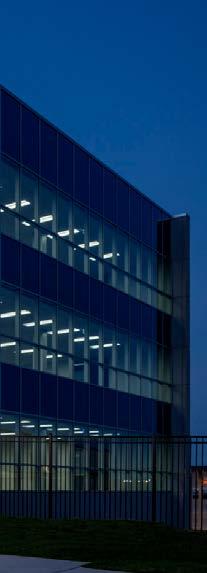



CONTENTS 5
Your Fuel
taste for
her to expand
venture into fuel and convenience.
Find
Heather Clark’s
challenge allowed
Walmart’s
P. 84
Theresa Joy Hannig was drawn to the WilliamsSonoma team through her own childhood experiences. P. 72
Abbigale Whitfield ( Walmart), Courtesy of Williams-Sonoma (Williams-Sonoma)
6 CONTENTS AMERICAN
QUARTERLY INDEX OF PEOPLE & COMPANIES OFFICE 825 W. Chicago Ave. Chicago, IL 60642 American Builders Quarterly® is a registered trademark of © 2020 Guerrero, LLC. CREATIVE VP, Creative Kevin Beauseigneur Director, Editorial Kevin Warwick Director, Design Topher Ellsworth Managing Editor Melaina K. de la Cruz Senior Editor Frannie Sprouls Editors KC Esper Kathy Kantorski Hana Yoo Staff Writers Sara Deeter Billy Yost Contributors Cyndi Fecher Will Grant Russ Klettke Lior Phillips Stephanize Zeilenga Senior Designer Lauren Keeling Designer Gretchen PeGan Photo Editors & Staff Photographers Cass Davis Gillian Fry Production Assistant Andrew Tamarkin CORPORATE CEO & Publisher Pedro A. Guerrero Chief of Staff Jaclyn Gaughan VP, Sales Kyle Evangelista VP, Hispanic Division Vianni Busquets Senior Events Manager Jill Ortiz Senior Director, Finance David Martinez Director, Client Services Cheyenne Eiswald Senior Client Services Manager Rebekah Pappas Director, Talent Acquisition Elyse Schultz Talent Acquisition Manager Haylee Himel Director, Business Development Jenny Vetokhin Director, Strategic Partnerships Krista Horbenko Director, Strategic Accounts Taylor Frank Senior Director, Sales Ben Julia Sales Training Manager Alexa Johnson Content & Advertising Managers Norman Edwards Jack Harper Peter Kennedy Cameron Macko Caitlin McManus Brooke Rigert SUBSCRIPTIONS + REPRINTS Printed in China. Reprinting of articles is prohibited without permission of Guerrero, LLC. For reprint information, contact Stacy Kraft at stacy@guerreromedia.com. guerreromedia.com ABC Abrams, Sarah 124 Baker Hughes 120 Buzzetto, Deidre 100 C&S Wholesale Grocers 94 Clark, Heather 84 Corini, Ned 61 Crestron Electronics 78 DEFGHIJ Earth Fare 23 Exelon 18 First Watch 113 Gilead Sciences, Inc. 130 Greathouse, Roy 52 Gross, Nona 28 Hannig, Theresa Joy 72 iPic Entertainment 106 IQVIA 61 Iron Mountain 124 KLM Karp, Sandy 106 Kuo, Deb 18 Lenovo 100 Magnuson, Ryan 58 McFaul, Sean 88 McLenaghan, Alan 116 Morin, Anthony 78 NOPQRS Portland State University 46 Poth, George 66 Puccino, Suzanne 42 Regeneron 66 Ropa, Bethany Logan 34 SageGlass 116 Seale, Mark 120 Spradlin, Melody 130 Stanford Health Care 10 TUVWXYZ UBS 34 University of Chicago Medicine 58 Verizon 28 Vertex Pharmaceuticals 88 Walmart 84 William Lyon Homes 52 Williams-Sonoma 72 Williams, Nick 94 Wilmot, Helen 10 Wright, Becky 23 WSP 42 Zalkow, Dan 46 Zimmer, Nathan 113
BUILDERS
Renovating the Industry
When you start typing “women in the building industry” into a Google search, one of the first suggestions that appears is “where are all the women architects.” What seems likes a ridiculous question—especially considering the multitude of projects women have been responsible for over the course of decades—stems from a history of underrepresentation. Even as recently as the ’90s, the percentage of womenowned architecture firms was still in the single digits.
But that’s changing. While women still only make up about 9.9 percent of the construction industry, there are various programs and panels in place to help them earn the recognition they deserve. For this edition of American Builders Quarterly, we’re hoping to contribute to that.
In this issue, we’ve opted to stray from our traditional style of a single spotlight and particular pattern of stories. Instead, we’re devoting an entire platform to the voices of women in the construction industry because they offer perspectives on what it means to strategize, lead, and inspire as women in the field (p. 8).
Read on and you’ll find executives from all walks of life and industries sharing their latest endeavors, from the improvements of training programs for Crestron Electronics (p. 78) to the sustainability efforts at Portland State University (p. 46) to the nostalgia-infused comforts of upcoming Williams-Sonoma locations (p. 72).
Our premier issue of the year is one I feel especially connected to. The women who appear throughout this issue impel me to rethink the ways in which I work and advocate for my own ideas. They instill a kind of confidence that inspires me to write their words on Post-it notes and adorn my desk with their secondhand mementoes. And it doesn’t stop there. From a production standpoint, American Builders Quarterly’s entire team is a powerhouse of talented individuals whom I love to learn from and share ideas with.
I closely collaborated with Lauren Keeling, Cass Davis, and Gretchen PeGan to develop the layout and visuals you see throughout the magazine. These three creatives motivate me every day and have helped me grow as an individual, both personally and professionally. That level of teamwork is a theme you’ll often find within each of these stories.
So where are all the women architects? They’re all around you—and you can find some in these pages. As we kick off 2020, I hope you feel energized by their stories.
Melaina K. de la Cruz Managing Editor


EDITOR’S LETTER 7 Caleb Fox
There is evidence of the contributions women have made to the built world throughout history. They have carved a place for themselves in the industry, despite receiving only a fraction of the recognition granted to men.

In this issue, six women claim space to share their perspectives on what it means to lead, inspire, and evolve as executives in their fields.
STILL LIFE PHOTOS BY CASS DAVIS


PERS PECT I SEV QBA 10
Pushing Boundaries
How Helen Wilmot works with Stanford Health Care’s unique faculty members to manage the institution’s leading-edge and ever-expanding healthcare facilities
BY SARA DEETER | PORTRAITS BY WINNI WINTERMEYER
PERS PECT I SEV QBA 11
When Helen Wilmot joined Stanford Health Care in 2005, it was the start of a new era for the institution.

At the time, Stanford was building the Stanford Medicine Outpatient Center, the first large, offcampus facility for the clinical program. Because it signaled the beginning of a new period of expansion for the healthcare system, the construction of the Outpatient Center also necessitated a shift in Stanford’s workflow processes and the need to create the “Stanford culture” for a large number of employees away from the main campus. Wilmot didn’t mind the challenge presented by the transition, though. Far from it.
“Stanford is a complicated, layered system of care providers, processes, and patients,” she says. “But I consider myself successful when I can clearly define a situation and then work to solve the problem. That’s important to me—the ability to absorb what’s going on around me, categorize it, and figure out how to make it effective for the patients and care providers.”
During Wilmot’s tenure at Stanford, first as vice president of ambulatory care and now as vice president of facilities, services, and planning, the organization’s footprint has only continued to grow. Wilmot currently oversees approximately 140 facilities across Stanford Medicine, including the children’s and adult healthcare systems, imaging centers, outpatient centers, physician and clinical offices, administrative buildings, and a call center that receives about 17,000 calls on any given day.
But those are just the existing facilities under Wilmot’s purview. She also helps manage the expansion of Stanford’s clinical campuses into areas such as Redwood City, South Bay, Sunnyvale, and Emeryville, as well as the construction of the new, 824,000-square-foot adult hospital on the inpatient campus. Stanford’s hospital, Wilmot says, is one of the most significant projects to be undertaken not just at Stanford but in the country at this time.
PERS PECT I SEV QBA 12

PERS PECT I SEV QBA 13
StanfordHealthCare
Helen Wilmot VP of Facilities, Services & Planning

14 PERS PECT I SEV QBA
“We’ve been working on it for 12 years,” Wilmot says of the new hospital. “At $2.2 billion, it’s actually the single largest investment in a hospital in the United States at this time. I have been responsible for the operations planning and activation of the hospital, and when it’s finished, I will be responsible for the facilities management of the new hospital and for repurposing the existing hospital that was established circa 1989.”
Naturally, Wilmot has encountered a few challenges in the course of establishing these various facilities. “It is incredibly difficult to find real estate that fits the profile of what is required in the Silicon Valley real estate market,” she explains. “You have to look at the location—is there parking? Is it accessible to public transportation? You also have to consider the age of the building, the size of the building, and of course the needs of your customers, whether that’s your internal staff or the patients.”
According to Wilmot, Stanford is a unique environment to work in that is created through a natural byproduct of the type of faculty and staff employed at Stanford. The faculty is distinctive, Wilmot says, relative to community medical centers. “They have significant clinical knowledge as well as a scientific and academic focus,” Wilmot explains. “So, there is a constant push towards improvement, discovery, and new ideas, exactly as you would find in an academic environment.”
As a result of that blend of clinical and academic approaches, Wilmot says, Stanford is able to provide high-level, cutting-edge medical care. But she also finds that it results in pushback against the idea of using mainstream processes, standards, and templates. When the faculty and staff work within a cycle of curiosity and innovation, she notes, the preference trends toward more customized projects and concepts.
The Next Generation
Wilmot has passed on her determination and resilience to her daughter, Tierna Davidson (#12), who helped the US women’s national soccer team win the World Cup earlier this year. Wilmot says her daughter is the youngest player on the USWNT World Cup team since 1995.
“She’s a strong individual,” Wilmot says proudly. “Tierna has done this herself, in an overwhelming situation.”
Like her teammates, Wilmot’s daughter is joining the fight for equal pay in sports. Wilmot says that during the NYC celebratory parade held in honor of the USWNT, her daughter stood next to Governor Cuomo holding a placard stating, “Parades are cool, but equal pay is cooler.”
In the expanded campuses in Redwood City, Sunnyvale, Emeryville, and other regions surrounding Stanford, Wilmot has paid tribute to that preference, supervising the operations planning and activation of custom-built and customrepurposed facilities.
Despite those challenges, Wilmot loves working with and guiding the Stanford faculty and staff. “We attract a high-performing group of people,” she says. “From entry-level staff to front-line clinical providers there’s a desire to do more than just work—they aspire to have continuous improvement and work in a dynamic environment where there’s a constant infusion of ideas and challenges.”
That philosophy of “continuous improvement” fits in perfectly with Wilmot’s own mind-set, which she developed during her time in the consulting world. To Wilmot’s mind, there are endless opportunities for everyone, both clinical providers and non-clinical staff of all genders, to seek guidance and continue growing.
PERS PECT I SEV QBA 15
Swinerton celebrates Helen Wilmot for her leadership in delivering innovative and progressive healthcare. It has been an honor to partner with Helen and her Team at Stanford Health Care over the years, doing our part in building exceptional patient care environments—and making a difference—together. Congratulations! swinerton.com
PERS PECT I SEV QBA 16
When it’s finished, I will be responsible for the facilities management of the new hospital and for repurposing the existing hospital that was established circa 1989.
–Helen Wilmot

PERS PECT I SEV QBA 17
Attitude
Determines Altitude
Post-retirement, Deb Kuo reflects on the greatest lessons she learned throughout her 17-year career at Exelon
BY KC ESPER
PERS PECT I SEV QBA 18
When Deb Kuo moved from Deloitte to Exelon 17 years ago, she was met with what she calls, “a big culture shock.” At the time, Deloitte was a larger, faster-paced business that functioned using the mentality that if it didn’t keep up with the changing times, it would fall behind. As a senior manager in the firm’s management consulting practice, she was expected to move quickly from client to client, always being mindful of critical context and client expectations in order to rapidly and efficiently achieve objectives while providing effective solutions to make an impact.

Meanwhile, Exelon was still on its way to becoming the massive corporation it is today. Kuo came into the energy company still blazing from the fire that Deloitte set inside her and, needless to say, quickly realized her new organization was on a separate mission and her new colleagues were operating a slightly different pace than to which she was accustomed.
“I was the first outsider to come into the real estate and facilities organization,” she recounts. “Not only was I entering into a newly created position to develop a portfolio strategy that had never been done before, but I was also not someone who had ‘grown up’ inside the company. There was certainly a sort of discomfort that I felt with my colleagues and within myself. I quickly realized that I had to change my own style if I was going to be effective inside the company.”
Kuo’s first year taught her as much about her work and leadership styles as it did about herself. She was coached to adjust her pace to connect with her colleagues, while keeping her sights on her department’s growth as well as her own.
PERS PECT I SEV QBA 19
David Rehor
Deb Kuo Vice President , RealEstate & Facilities Exelon
Attracting the attention of several senior leaders, Kuo tapped into the wisdom of her new mentors at Exelon, adapting her approach to developing a portfolio strategy with her colleagues that encouraged everyone to advance. “One of my mentors would say, ‘Your attitude, not just aptitude, determines your altitude.’ I realized I had to adjust my attitude, so that my colleagues would recognize that I was interested in––and needed—their help and their feedback. Then, we could walk together,” she says. Kuo developed her leadership style to be much more inclusive, patient, and forgiving. Eventually, her colleagues recognized her willingness to work hard to build their collective success and became energized to work alongside her.
“Surrounding myself with people who are smart and curious, and motivating my team to work with me created a huge advantage in terms of leading the team to a place we could be successful,” Kuo says.
After her first year, Kuo’s career at Exelon flourished. She continued to build upon the lessons she learned over the next 16 years, meeting her colleagues where they were while maintaining her unflagging curiosity and drive. Together, she and her team conquered incredible feats, including developing and delivering Exelon’s new Baltimore headquarters at the end of 2016. “We made a commitment to Baltimore when we merged with Constellation Energy,” Kuo says. “There was a lot of angst in the community centered on the impact Exelon might
Exelon’s Baltimore headquarters invested in minority- and women-owned businesses to cover 75 percent of the construction, design, and furnishings.

PERS PECT I SEV QBA 20
Alain Jaramillo
The open layout of Exelon’s Baltimore headquarters allows natural daylight to stream in, while simultaneously reducing electric consumption.

make. It was a sensitive project, but when I was asked to head it, I was excited to be part of it.”
Kuo and her team designed the headquarters in a way that built upon the company’s environmentally conscious personality, while quelling Baltimore’s anxieties around potential repercussions. The project not only serves as an icon for Exelon’s progressive workplace, it also serves as an example for how it responsibly goes about “cultivating and developing minority and women-owned businesses that may typically be too small to work on large projects” as the company joined forces with local contractors and service providers to complete the job.
As a determined, esteemed woman of color, Kuo’s modus operandi has been to erase the limiting stereotypes attached
to minority groups and females. Her own journey separated her from traditional, Asian career paths in the engineering and medical fields. Instead, her love of design and architecture inspired her to forge what was considered a rebellious career path, proving that a job outside of medicine could be practical and honorable. As she moved up Exelon’s ladder, she paved her way as the company’s first real estate and facilities executive and oftentimes, the only Asian woman in Exelon’s leadership ranks, breaking the mold she was expected to fit into. She was determined not to be defined by the boundaries set by others. Each position Kuo has held was created for her, she says, to challenge her with opportunities to continuously learn and grow. After seven years in her last position as vice president of real estate
PERS PECT I SEV QBA 21
Karl Connolly
Surrounding myself with people who are smart and curious created a huge advantage.

and facilities, Kuo realized that for her, the next frontier for personal growth and exploration lay outside Exelon, and she retired, appreciative of the legacy Exelon enabled her to leave behind.
“Deb was instrumental in elevating the mission of the real estate and facilities team at Exelon,” says Griffin James, now senior manager of real estate transformation at Deloitte Consulting LLP, who worked with Kuo during their time at Exelon. “Her leadership helped executive leadership understand the value real estate assets have to both enhance employee experience and support the company’s bottom line.”
Now, as Kuo reflects on her professional career early in her retirement, she recognizes how her work has molded her into the person she is today. Inevitably, Kuo has become a leader, an exemplar, a mentor, and a trailblazer. She learned that “being a leader is recognizing that not everyone has the same objectives or goals as you do. You have to recognize people for who they are and what they want so that you can support them and still encourage them to be valuable contributors to the team.” With her time now in her own hands, she hopes to continue the legacy she began as an inquisitive creator of change.
Savills congratulates Deb Kuo for this well-deserved recognition. Your leadership, knowledge, and passion are a driving force. We are proud of our long-standing partnership in finding the right real estate solutions for Exelon. Savills has elevated the potential of workplaces for over 160 years. Learn more: savills.us.
PERS PECT I SEV QBA 22
It Just Comes Naturally
Becky
Wright shares what it means to inspire healthy living— for herself, her team, and her customers
BY CYNDI FECHER
PERS PECT I SEV QBA 23
It’s not every day that you get the chance to work at one of your favorite companies. When Becky Wright was presented with the opportunity to join the team at Earth Fare, where she was already a loyal customer, she happily accepted the position of vice president of construction.
“Earth Fare aligns very nicely with my beliefs,” Wright explains. “I believe in the concept, as a mother and as a healthy person.”
The health and wellness supermarket chain with 53 locations across the South and Midwest is headquartered in Wright’s home of Asheville, North Carolina. Originally known as Dinner for the Earth when it was only providing a small selection of natural foods, the company expanded to a full-service grocery store in the early 1990s and is now one the largest natural and organic food retailers in the US.

Wright’s background is in retail construction, so bringing her skills to an environment that upheld her values was the opportunity of a lifetime. “To be able to be instrumental in the company’s growth model, expanding into new markets and bringing our concept of healthy living to newer markets, has been really exciting,” she says.
The concept of healthy living that Wright refers to is the “Live Longer with Earth Fare” Food Philosophy. While that brand promise was officially launched in 2017, the particular philosophy that forbids hundreds of harmful chemicals and ingredients from making their way onto their shelves has been in place for much longer. All products sold are free of high-fructose corn syrup, artificial fats and trans fats, artificial colors, artificial preservatives, artificial sweeteners, and bleached or bromated flour,
PERS PECT I SEV QBA 24
t VP o f C o n s tur c t i o n EarthFare
BeckyWrigh
Bradlee Hicks
and are never administered antibiotics or growth hormones.
“As a healthy eater, and especially as a mom, I don’t have to read the labels at Earth Fare—I know there’s nothing in the store that is going to be an unhealthy choice for our family,” Wright explains. “Many of us have come to the conclusion in this day and age that what you put in your body is important, and to be able to align that with what I do for a living has been incredibly valuable.”
Wright’s role at Earth Fare is expansive and touches many aspects of the business.
“I'm fortunate enough to manage everybody from a refrigeration tech all the way through a licensed architect,” she says. “I really get to see all the pieces from the ground up.” Her team comprises
grocery and retail professionals, architects, field maintenance techs, project construction managers, a design team, and more. She also works closely with the vice presidents of operations and merchandising as well as the CEO of Earth Fare.

“It’s a very collaborative atmosphere here at Earth Fare,” Wright says. “We’re all intimately involved in each of our stores.”
That close involvement includes direct feedback from the communities Earth Fare serves. The organization sets up a community advisory board for most stores as they open their doors, which remain in place throughout the first few months to help the location acclimate effectively to its new neighborhood. “Those groups come in and give us feedback about what our store can offer for each community,”
PERS PECT I SEV QBA 25
LED bulbs and skylights reduce energy usage.
Wright says, “and we're responsible for translating that feedback into action. We want to exceed the expectations of the community.”
The many moving parts don’t faze Wright. “The commercial retail business is just not a nine-to-five job—most of our stores are open from 7 a.m. to 11 p.m.” Because her team supports construction as well as repair and maintenance, it simply can’t be a clock-in, clock-out mentality. “All of my team has that commitment,” she says. “It’s not just the maintenance techs that get the phone calls. Sometimes it’s the design architects that are needed on weekends or after hours, or we want to walk through a store before opening to see it through the customer’s perspective.”
Yet her team’s work/life balance is extremely important to Wright. “I want to allow the team to commit fully to their jobs and work hard when we need them to work hard, but knowing that their needs will be addressed in their personal life with a little bit more focus,” she says. “I believe that a happier employee
translates into a happier business model, which translates into higher customer satisfaction.”
Higher customer satisfaction seems to be no problem for Earth Fare, as the company is expanding by more than 50 stores in the near future to meet the demand for healthier options across the US. “People are eating healthier; people are paying more attention,” Wright says. “People are not eating as many processed foods. They’re thinking about what they’re putting in their bodies and how much rest they’re getting.” The trend is widely expanding, Wright says, and Earth Fare has been at the forefront of this thinking since its institution.
Earth Fare’s concept is not just about eating healthy, Wright says. It’s about living healthy, which also has an impact on her life. “That has to translate beyond your workplace to your personal life, your work life, volunteering in your community, or being involved in your kid’s school. All of that needs to be wrapped up into one life.”
Becky Wright is tasked with launching Earth Fare’s mission of “bringing healthy food to everyone, everywhere” to life.

PERS PECT I SEV QBA 26
Bradlee Hicks


For the Planet and the People
Through the span of her distinctive career, Nona Gross shares the practices and passions that have guided her as she seeks to be a coach for the next generation of leaders
BY MELAINA K. DE LA CRUZ
PERS PECT I SEV QBA 28
Finance. Healthcare. Pharmaceuticals. Automation. Communication and technology. Nona Gross’s diverse resume might surprise some, but the leader in global real estate for Verizon says that her choice to move through this variety of careers has been deliberately curated. “All these companies have something special and unique, and they contribute to humanity in ways both seen and unseen.” She continues that each organization she’s worked for has excelled in their respective industries and have all given her indispensable insight and exposure.
A graduate of the University of New Mexico’s business and medical schools, where she earned a bachelor’s in medical law and ethics, Gross says that this background has played an integral role in her professions. “I’d like to think that the things I’ve achieved in my career are very much aligned with my personal values and beliefs. I work for companies I am very proud to represent.”
Gross’s career began in commercial real estate, where she served as an assistant facilities manager for Citibank. This is where she first found an opportunity to tap into her passion

for sustainability, as the company was an early adopter in being communityand eco-friendly. “Even before being LEED-certified and being green was in fashion—or what it is today—Citibank was very much involved in running its facilities in a sustainable manner.”
This is also where she found her first mentor, a facilities manager who took Gross under his wing and taught her everything from excellent customer service to various building systems to construction principles and strategy. He also supported her as she developed a program that encouraged all commercial businesses within Albuquerque, New Mexico, to promote recycling. As the chairperson of the Albuquerque Recycling Committee, Gross later received the Green Zia Award for these efforts.
Armed with a strong knowledge of facilities management, Gross continued her on-the-job studies of workplace strategy and sustainable building practices through a five-year tenure at Merck and a role in furniture manufacturing at Steelcase, before landing at Kaiser Permanente as a consultant. “I was brought on board to help them plan what they refer to as a ‘template hospital,’” she says, explaining that the project entailed the development of specific standards that a hospital would need to meet. Specific hospital designs were placed into the template like “puzzle pieces,” thus creating healthcare facilities that met requirements in a streamlined way and reducing the time it took before they could open their doors. This opportunity to work in facilities development served her well at her next venture—in design planning and workplace strategy for Siemens when they were first developing a pharmaceuti-
PERS PECT I SEV QBA 29
NonaGross Global Real Estate Verizon Lisa Chouteau
cal factory for Siemens Healthcare, a separate entity within the multinational conglomerate.

“When I first took that job, I knew nothing about building a pharmaceutical factory,” Gross admits. “But the global supply chain’s VP knew that I had many talents that would contribute to the success of the team’s projects.”
Indeed, Gross proved to be successful in the role and even developed a specific process that streamlined a 52-week process to just 32 weeks. This process was something she bequeathed to the team when she eventually departed the company. “When I was leaving, the VP asked me if I named my replacement,” she recalls. “I told him the good thing is that I didn’t need one—the processes I put forth are executable! You have them; now you just need to put them in place.”
Nona Gross!
Throughout her career, Gross credits the mentors and supports she’s met through each industry to helping her not only grow her skill set, but to give her a seat at the table. Finding that platform to share ideas is something that she laments can be a challenge, especially for women and minorities. “I’ve always dealt with women in construction not being acknowledged for the expertise we bring to the table,” she says. “I’ve been shushed in meetings. I’ve learned to stand up for myself, to be a voice to be reckoned with, and to understand that I have something valuable to contribute.”
Gross seeks to advocate for young people and be that mentor wherever she can. She reminds them to stay curious and be confident, as they “know what they know.” She has compiled an extensive “toolbox” of lessons learned that she is proud to share with them, cobbled from her own experiences and advice given to her by her own mentors.
As a woman in the workforce who has garnered a wealth of exploits and industry knowledge, one might expect that she plans to relax after she retires. Instead, Gross says that she plans to continue tapping into her affinity for human connection by working with the International Rescue Committee (IRC).
A first-generation American herself, Gross is moved by the work the organization does to help present-day refugee children and families. “There are global struggles everywhere,” she says. “I have a great skill set I could bring to them, from supply chain logistics to construction to understanding how hospitals are run.” In her previous roles, she was even provided opportunities to help with disaster relief efforts.
“I think that people around the globe and in our own communities need help,” the former ethics major says. “Being able to help in whatever way I can through the skills I have developed will be very rewarding.”
PERS PECT I SEV QBA 30 Congratulations
We are proud of our relationship with you to create inspirational environments.
knoll.com
Nona Gross’s Toolbox for Success
1.
Have Confidence
“With preparation and subject matter expertise, you’re really able to focus your ideas and initiative to get the support you need to execute on projects. I had an executive coach who would say to me, ‘Fake it ’till you make it.’ It gave me the mind-set to move forward knowing I had prepared well and was informed on the topic.”
3.
Find Your North Star
“I really have to have a shared zeal with others—a common goal. A VP of mine had a “North Star” approach for his team by reminding us that we were all pulling in the same direction, toward a common goal to succeed as one. Not only does a shared vision create dynamic teams but it motivates you to get up each morning, knowing that you’re going to be working with great people on a mission that matters.”
2. Show Up
“Thirty years into my career, I still think about showing up if you want a seat at the table. You want people to recognize you as being a leader and valued contributor to the team, which, to me, also means that you make sure you’re doing something that you love, find interesting, and can really commit to.”
5.
Never Stop Learning
4.
Build Your Team
6.
Be Resilient
“One thing is for certain: everything changes constantly. Understanding that change is inevitable then managing it is an art you should learn early because we experience it in every part of our lives. Resilience will teach you that you cannot control things that are out of your control, but you can control your own reaction to situations.”
“Find a company that shares your personal values. This will drive you to promote the company, discover engagement events, and network with a variety of people from different roles and levels. It gives you a sense of pride when you know that you are contributing to the wellness of a larger community.”
7. Welcome Vulnerability
“I’m vulnerable because I’m not always the expert, but I still have something to contribute, and to that end, there is a level of success in being vulnerable. In many ways it keeps you humble and accessible to new ideas and people. Being open, listening, and having humility are better ways to forge alliances. Nobody likes a know-it-all!”
“I’m a continuous learner. There are many webinars, industry classes, seminars, and certifications targeted toward professional accreditations. Find what interests you and learn. I think it’s very important both to stay current, and to craft your career by meeting people outside of work in the community.”
8.
Keep a Big Picture Outlook
“There are aspects of life that connect us and bring us back to each other. We are going to celebrate wins and weep over painful losses. Aside from your specialty skills, soft skills, education, and work experiences, it’s all of these takeaways that you collect in order to be a happy, joy-filled, and successful human being.”
PERS PECT I SEV QBA 31
PERS PECT I SEV QBA 32
I’ve been shushed in meetings. I’ve learned to stand up for myself, to be a voice to be reckoned with, and to understand that I have something valuable to contribute.
–Nona Gross

33 PERS PECT I SEV QBA
Should You Find Yourself the First
UBS’ Bethany Logan Ropa on development, leadership, and unplanned pioneering
BY BILLY YOST | PORTRAITS BY GILLIAN FRY
PERS PECT I SEV QBA 34

PERS PECT I SEV QBA 35
“I was not expecting to be a trailblazer in this business,” Bethany Logan Ropa says. “I thought the generation prior to mine had already paved the way and that I would follow along in their footsteps.”
When Ropa joined UBS Investment Bank after a successful summer internship experience, she anticipated that investment banking would be substantially more diverse.
Now as a managing director in the real estate, lodging, and leisure group for the Swiss multinational investment bank and financial services company, Ropa found herself to be the most senior woman on the team quite early during her career there. As the first woman in the company’s global real estate investment banking business to get promoted to managing director and the only female managing director of the bulge bracket banks in New York covering the real estate sector, Ropa is now intent on connecting more women in the real estate sphere while continuing to build and strengthen client relationships at UBS.
Part of this is helping to give people a clearer understanding of what exactly investment banking is. “I advise on strategic transactions and raise capital, including debt, equity, and everything in between,” Ropa explains, adding that she works with both public and private owners of real estate. “On the advisory side, there are many types of transactions—portfolio sale, spin-off, corporate merger, public to private.”
Early in her career, Ropa had the dubious benefit of trial-by-fire. “I came to UBS straight out of business school in 2008, just in time for the market to crash,” Ropa recalls. The apprenticeship-style training of investment banking was alluring and operating deep in the trenches amid general economic chaos was a unique learning opportunity for the first-year associate.
Ropa says the gender disparity of her industry wasn’t immediately apparent. “In business school, nearly 30 percent of my class was female and plenty were planning to go into banking,” she says. “But when I started at UBS, of the 65 in my associate class, only six of us were women.”

Growing up with brothers, Ropa said she never felt like an outsider among her team, but as she rose in the organization, she increasingly wanted the guidance and perspective of senior women who could provide context and scope to what a successful career in her field might look like.
“I went to the senior members on my team and asked them if they knew any senior women, either in investment banking or the real estate sector more broadly, that might fit that role,” Ropa says. “One of the managing directors I worked closely with connected me one of his clients who was a CEO running a public REIT, and for that I am forever grateful.”
The mentorship experience was so encouraging and empowering that Ropa continued to seek out her own portfolio of senior women in positions
PERS PECT I SEV QBA 36
of leadership, and she says it has been key to her continuing development. “I needed to see successful women who were a couple decades ahead of me, and I sought it out. If other women find that they’re not getting that kind of mentorship, I would encourage them to ask for help in finding it.”
Ropa believes that learning to be more vocal was also crucial to her success. “Women often don’t like to talk about the political portion of this business, but it is important,” she says. “Managers aren’t just looking for talent; they’re looking for someone who shows the desire to take on a role.” She continues that many women put their heads down and assume that if they work hard, they’ll be tapped for those jobs when the time comes, but it’s not always the case. “They don’t come for you because they don’t know you wanted it,” Ropa says. With that in mind, she has worked extensively to unite and support women looking to continue developing their careers, both internally at UBS as well as in the real estate industry more broadly.
In 2018, Ropa launched an annual UBS Women in Real Estate dinner in conjunction with an annual real estate conference in New York City. After a successful gath-
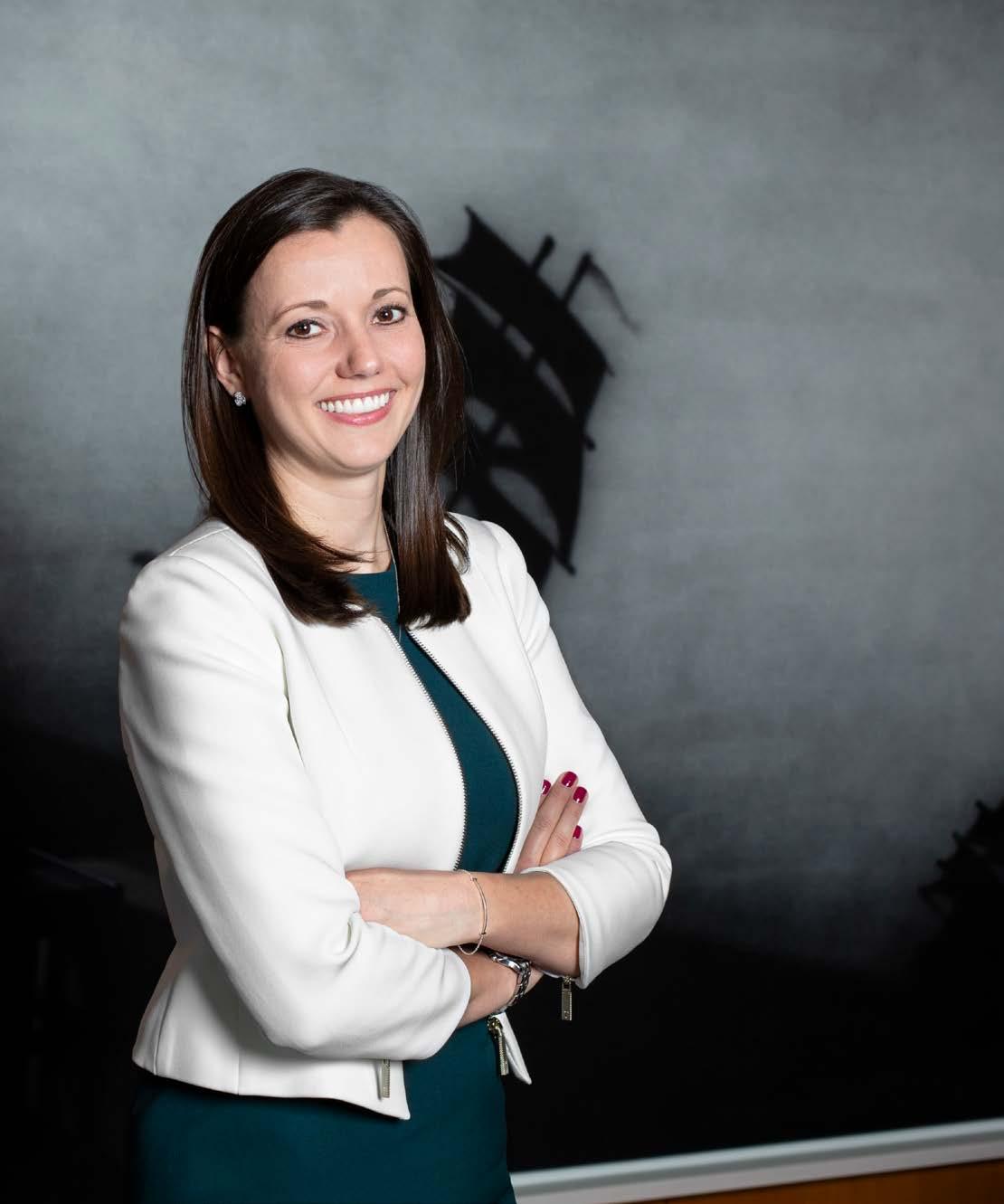
PERS PECT I SEV QBA 37
Bethany Logan Ropa
ManagingDi rectorofReal Estate, Lodging & Leisure
UBS
ering of 30 C-suite leaders, board members, and women in rising roles, the momentum has continued in 2019 with the second annual UBS dinner held in early June.
“There are incredible women across the real estate industry, and I wanted to help them to meet each other,” Ropa says. “I’m tired of the narrative that women don’t help other women, because I’ve found the complete opposite to be true in my career. I’ve found women in my industry to be so helpful and supportive, and I want to be that too.”
One of the ways that Ropa demonstrates this passion is through her work with multiple diversity initiatives at UBS. She is on the steering committee for Women in Investment Banking, a member of the IB Diversity Council, and helped to launch a program called RISE, which focuses on empowering mid-level women in the bank. In 2019, Ropa became the senior sponsor for her division’s sophomore diversity internship program, which has recently been expanded to include interns from underrepresented minorities and the LGBTQ community. “I want to take the lessons we’ve learned from initiatives focused on gender diversity and apply them to making the bank more diverse and inclusive for everyone,” she says.
While it was not part of Ropa’s original game plan to be a pioneer for women leaders in her industry, she says she has become passionate about the work she is now doing to pave the way for more diversity. “I know what it’s like to come into an organization not look like anyone there,” she says. “Thinking about those who aren’t in the room and working to get them here will make us all stronger.”
The Apple Doesn’t Fall Far
As a self-described “older millennial,” Bethany Logan Ropa might not fit the job-jumping stereotype of her generation. “My friends from business school joke that I’m a magical unicorn because I haven’t changed jobs since graduation,” Ropa says. The chance to continue to evolve into new roles at UBS was worth staying around for and was also encouraged by her father, an electrical engineer in the power and utilities sector for more than 30 years.
“Over the years, he saw so many resumes of candidates with only two years of experience at each job. He had strong reservations about hiring them because he knew they would only put in a year before looking for their next job,” Ropa says. “In my early years at UBS, he really encouraged me to stick it out through tough times to build the necessary skills and experience before I considered making a move. I didn’t want to be the kind of person my dad wouldn’t want to hire.”
PERS PECT I SEV QBA 38
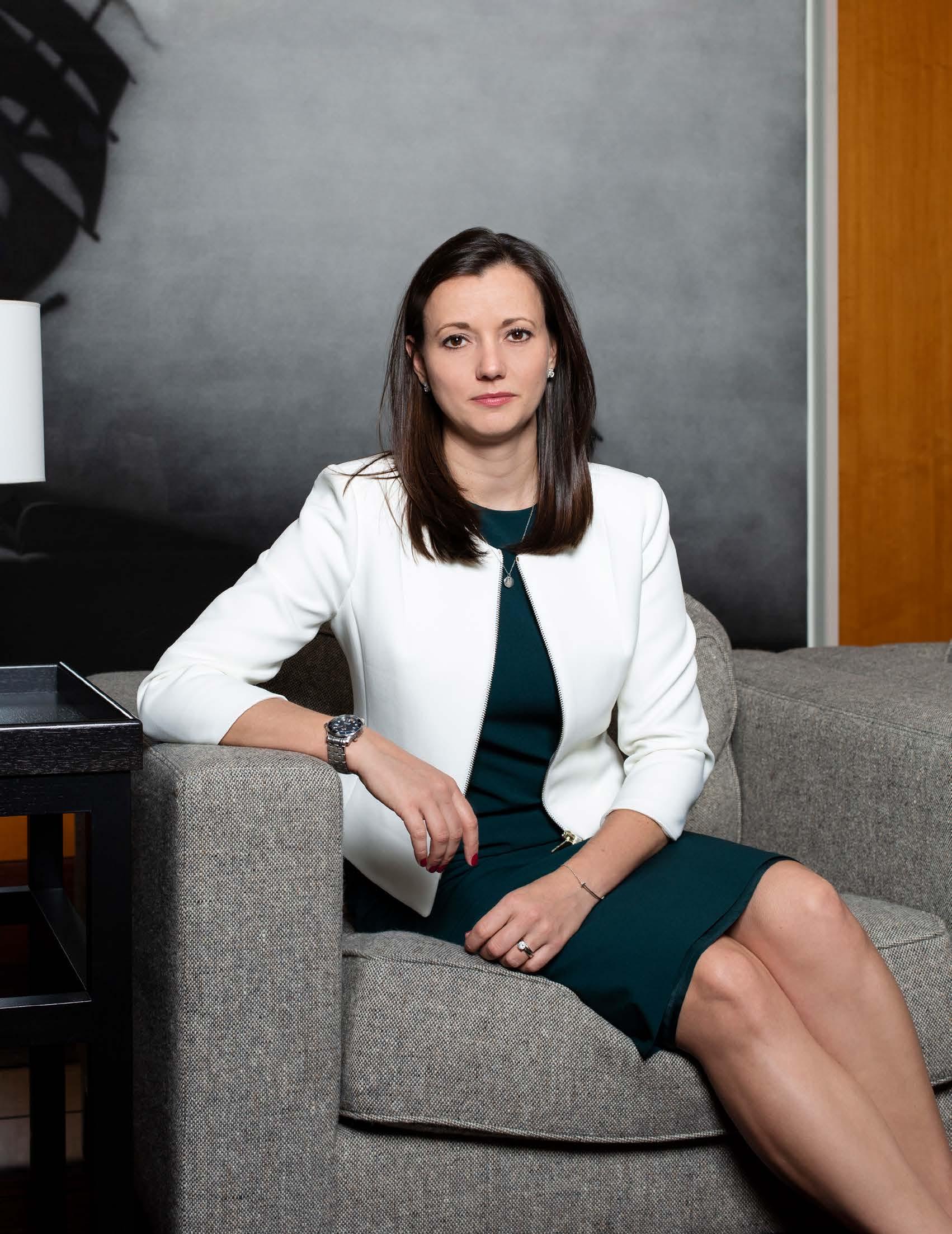
39 PERS PECT I SEV QBA
PERS PECT I SEV QBA 40
I’m tired of the narrative that women don’t help other women, because I’ve found women in my industry to be so helpful and supportive, and I want to be that too.
–Bethany Logan Ropa

PERS PECT I SEV QBA 41
An Active Participant
While Suzanne Puccino has been at the same place for 25 years, she’s done anything but stand still
BY BILLY YOST
PERS PECT I SEV QBA 42
When Suzanne Puccino went to work for Parsons Brinkerhoff, now WSP, more than 25 years ago, she likely wouldn’t have been able to imagine the company’s destiny for change. Over the course of her career, she’s seen WSP acquired two different times, which inevitably evolved her role and responsibilities. Two different executive committees have asked her to stay throughout the transitions. They simply didn’t have someone who could match her institutional knowledge or wide breadth of capabilities.
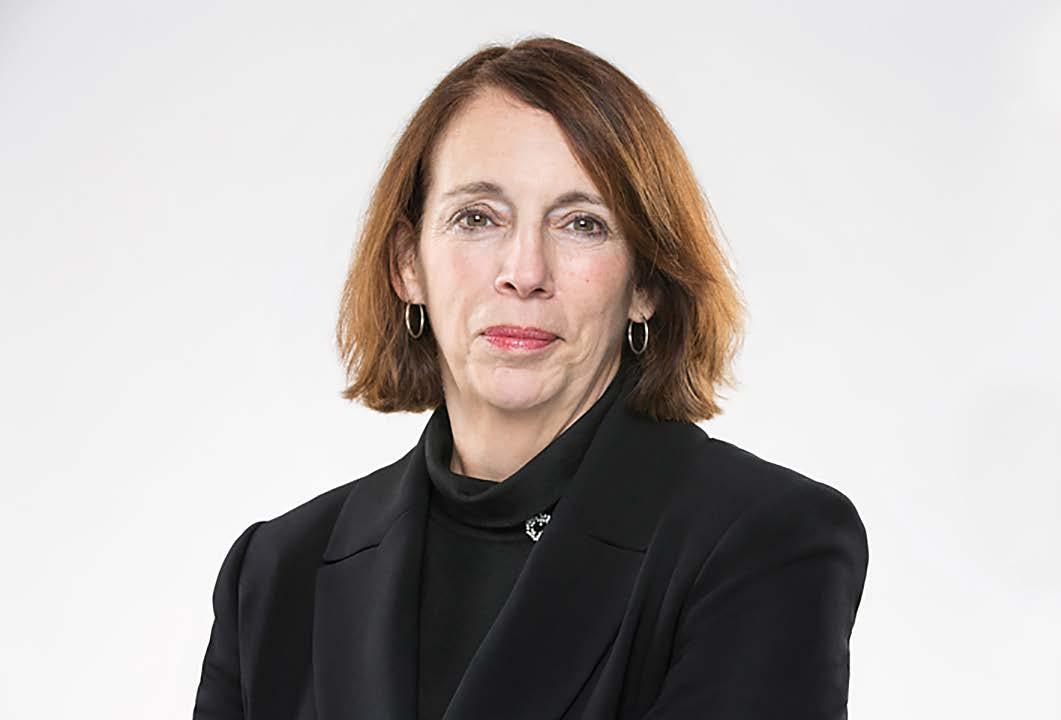
While Puccino can say she’s stayed at the same company for a quarter of a century, it’s both absolutely true and categorically false. The now SVP and director of workplace strategy at Canadian-based WSP has helped streamline both acquisitions of the company and countless acquisitions by it as well, all the while and all too often finding herself the only woman in the meeting.
Puccino says she was willing and excited to grow as her original employer both evolved and expanded its scope— in fact, that growth was encouraged within the company culture. “From the very beginning, we talked about ethics all the time; we talked about why it was so important to be transparent and truthful,” Puccino says. “When you’re surrounded by other people who believe that and who believe that it’s the right decision for the client, for yourself, and for the company, it’s an absolute win-win.” That commitment to transparency has remained and is kept in plain site by WSP’s president and CEO, Alexandre L'Heureux.
SuzannePuccino
SVP &Director of WorkplaceStrategy WSP
Adaptability is in Puccino’s DNA. From one day to the next, she can tackle corporate services, travel programs, and administrative functions, policies, and procedures. “I’ve always been a change agent, and that applies to myself, too. In making these changes over the years, my goal has always been to get the most value out of those new opportunities.”
Puccino combines her appreciation for the power of change with her ability to bridge gaps between the existing company and its new acquisitions, which makes her uniquely suited for a company that continues to redefine itself.
While rethinking the possibilities of her own role, Puccino has had to confront some of the harsh realities of being a woman in a male-dominated industry. “There are certainly times in my career
when I’ve been challenged by aggressive people, people who feel they have the right to fly off the handle, or people who feel like they have to create pressure to get what they want. I think you will find me pretty even-keeled in most situations,” Puccino says. “Over the years, I’ve had much more success with trying to cultivate respect and kindness and developing relationships.”
In often having to represent an entire gender in a meeting, Puccino found herself always working to be overprepared. “Especially when we were having construction meetings, the basics like being able to read a plan and have a basic understanding of what is being discussed were absolutely crucial,” Puccino says. “Early on, I did a lot of listening, learning, and homework.”
PERS PECT I SEV QBA 43
Courtesy of WSP
Nobody does less, and they shouldn’t be spoken to as if they do.
Puccino says that not being seen as passive served several purposes. “It requires you to be actively engaged and understand what’s going on.” And while she says she was keenly aware of her minority status in the room, she refused to let it dictate her own basic approach to her work.
The SVP says her eyes are always fixed on WSP’s three-year strategic plan. Two projects in particular are passion points for Puccino. “I’m on the sustainability task force, and our overall goal is to reduce our greenhouse gas emissions,” Puccino says. “What we do internally with our buildings can play a big role in that and help us be better global citizens.”
Diversity and inclusion are also high-priority matters at WSP. “As culture has evolved, I see many more young women in the workplace, which I think is great—but our diversity is not just gender,” Puccino says. “I’m really optimistic that not just WSP, but the world is willing to take on that mantle.”
Puccino offers simple but power advice to those hoping to follow in her footsteps. “This may sound trite, but you need to be prepared,” Puccino says. “Your general retention of issues is imperative, so when people ask you a question, you have an answer. I think it’s incredibly important.”
Integra has been delivering quality workmanship from a skilled workforce and professional project management team since 1989. We are committed to meeting the needs of our clients through innovation and economical solutions for each project.

Puccino also reemphasizes the need to consider what should be fundamentals of corporate and human interaction. “While you may not treat people at senior and junior levels exactly the same, you do have to do it with respect,” Puccino says. “Nobody does less, and they shouldn’t be spoken to as if they do.”
Most importantly, Puccino says that for many women, there will be ugly times. “But you can’t let that stop you. I’ve been fortunate that I’ve had people who supported me, and it’s really important to find those people for yourself.”
PERS PECT I SEV QBA 44
integra-construction.com CONSTRUCTION
CONSTRUCTION CONSULTING
MANAGEMENT
Section 02: Framework
Setting the stage and implementing the building blocks for what will soon be state-of-the-art facilities and designs from difference makers in the building industry
FRAMEWORK 45
The Pride of Portland
Portland State University is a commuter school where driving alone in a car is far from the norm. The head of real estate, and the city around him, have different ideas about transportation.
By Russ Klettke
46 FRAMEWORK

FRAMEWORK 47
Brad Feinknopf
The Karl Miller Center is home to PSU’s School of Business.
College campuses are complex environments. They typically include multiple buildings that not only serve teaching, laboratory, administrative, and residential functions but are also all connected by energy, water, and transportation systems. So, it’s fair to say that these learning institutions are types of organisms. More specifically, they’re organisms functioning within ecosystems that feature adjoining neighborhoods, local culture, municipal jurisdiction, and regional economics.
Portland State University is one such organism— and a fairly robust one at that. It’s a 28,000-student institution with a 50-acre campus situated in the heart of Oregon’s largest city. Almost 90 percent of its students are commuters, and how they commute is an integral part of the green story of the university. This is not by accident: the school’s associate vice president of planning, construction, and real estate, Dan Zalkow, began his PSU career as assistant manager of transportation and parking services.
“Immediately after starting at PSU, I began taking graduate courses in transportation planning,” says Zalkow, who ultimately earned a master’s degree in urban and regional planning. “I found the field

48 FRAMEWORK
Dan Zalkow Associate VP, Planning, Construction & Real Estate Portland State University
“I found the transportation field fascinating, especially as it related to landuse planning and the environmental benefits of commute modes other than driving alone.”
Courtesy of Portland State University
The Karl Miller Center reopened to the community in late 2017, when it became LEED–NC Platinum–eligible and reduced energy usage by more than 50 percent.

fascinating, especially as it related to land-use planning and the environmental benefits of commute modes other than driving alone.”
Those studies were spot-on for the job he has today: to Zalkow, it was all about the intersection of land use and transportation planning. Portland is an ideal city for making that happen, as it’s somewhat famous for its sustainability cred and culture. In fact, 42 percent of university employees and 50 percent of students take public transportation to the campus, while only 31 percent and 19 percent drive alone in a car, respectively. (Nationally, a whopping 76.4 percent of workers commute alone by car.) About 12 percent of employees and 5 percent of students commute by bike, while 5 percent and 18 percent walk. In 2013, the League of American Bicyclists awarded PSU with platinum status within the Bicycle Friendly Univer-
sity program, one of only five universities in the country presented with that honor.
But as every organism mutates, PSU has seen a two-thirds drop from 12 percent in 2010 to 4 percent in 2017 in students who bike. Why? Housing affordability near the campus is largely at fault, causing students to live farther away where biking is less practical. According to the Census ACS survey, the city’s median gross rent climbed almost 20 percent between 2014 and 2017, compared to about 6 percent nationwide. Clint Culpepper, PSU transportation options manager, adds that the increasing vehicular traffic that accompanies increasing population is also likely responsible for fewer bikers.
Transit use appears to have compensated for the drop in biking, not unlike a healthy kidney making up for a weaker one. This speaks to the culture of green
FRAMEWORK 49
Brad Feinknopf

50 FRAMEWORK
The light fixtures in the Karl Miller Center use daylight and occupancy sensors to reduce energy usage. Brad Feinknopf
transportation by any means—as well as the school’s fortunate position within a city grid that features buses, streetcars, a light rail and commuter rail, and even an aerial tram.
The PSU campus and the buildings within its orbit are equally green, earning enviable certifications and ratings. As early adopters of the LEED program, the school has 15 buildings with the certification, including four new structures achieving Silver and Gold in the operations and management category— which focuses on existing buildings—since 2017.
Adding a noteworthy new building that’s set to open in 2020 speaks not only to PSU’s sustainability ethos but also to its place in the broader Portland community and infrastructure. Known simply as the Fourth and Montgomery Building, the seven-story, 175,000-squarefoot structure will house four entities in a commercial condominium: Portland Community College, Oregon Health Sciences University, the Bureau of Planning and Sustainability, and PSU’s College of Education.
The $104 million building will also feature groundlevel retail, a bike garage—complementing 10 other bike garages elsewhere on campus and a 2,500-squarefoot bike shop—and a “bird-safe” exterior glazing that covers 40 percent of exterior walls and provides important natural lighting in the interior. Emergency stairwells are designed with glass walls to encourage occupant use in lieu of elevators. With an eco-roof, solar panels, and overall high-energy efficiency features (e.g., R-21 insulation), the university is on track to achieve LEED Gold certification.
Jennifer McNamara, PSU’s campus sustainability director, reports several other accolades achieved, including six years as a STARS Gold-rated university (sustainability tracking, assessment, and rating system), ranking 31st out of 953 participating institutions, and a top-50 ranking in the Sierra Club Cool Schools index. PSU’s Faculty Fellows of the Institute for Sustainable Solutions program, a cross-departmental network of 140 faculty members from different disciplines and expertise, supports research, shared knowledge, and financial support to interdisciplinary research teams.
Zalkow adds that the school exceeds design requirements of the Americans with Disabilities Act, instead using the more comprehensive Universal Design principals as a guide.
“I don’t consider any ADA requirements as stringent,” says Zalkow. “There are a lot of ways to exceed the mandates with just good design. It helps us with faculty and student recruitment and retention, and it’s in greater alignment with how teaching and research will be done in the future.”
In other words, this is an organism in an ecosystem that is built to be sustainable.
Founded in 1989 and working out of offices in Stuttgart, Munich, and Boston, Behnisch Architekten recently collaborated with Dan Zalkow and his team to complete the award-winning Karl Miller Center. Dan’s leadership was instrumental in fostering a collaborative team culture that harnessed the team’s strengths and collective wisdom.

FRAMEWORK 51
The Karl Miller Center features a passive-cooling atrium and pavilion.
Building with the Heart of a Lyon
William Lyon Homes’ Roy Greathouse finds ways to build affordably and practically in one of the country’s hardest markets: Northern California
 By Billy Yost
By Billy Yost
52 FRAMEWORK

FRAMEWORK 53
Courtesy of William Lyon Homes
William Lyon Homes operates with the motto “Building homes to live your dreams.”
The same work ethic that Roy Greathouse proudly inherited from his father is also the reason he can be a tough man to nail down. “We’re a little busy at the moment,” the director of construction for William Lyon Homes says over the clanging sounds of hammers and the high-pitch buzz of drilling in the background.
The Newport Beach, California-headquartered company has built over 100,000 homes since its 1954 founding, and, despite a year that by all expert accounts has been labeled a buyer’s market, Greathouse is helping William Lyon Homes stay on course by paying close attention to the everchanging demands of new homeowners and developing key relationships to navigate the increasingly complicated red tape of building in Northern California.
In a West Coast market where, after years of climbing prices, some homes are sitting for sale far longer than expected, Greathouse says that it’s more important than ever to pay attention to the shifting priorities of new homeowners. “These days in California, it seems like people are looking for simplicity,” Greathouse says. “They want those simple necessities in their homes that make their lives easier.” A focus on practicality means building homes closer to public transportation, an ever-increasing focus with the rushhour gridlock of the Bay Area.
Greathouse says recognizing and adapting to evolving homeowner expectations means continually educating himself and working collaboratively with all members of the Lyon team. “Whatever the challenge, we take it head-on and make sure that we get buy-in from our consultants, be it an architect or a third-party forensic consultant, to make sure we’re doing the right thing by our buyers.”
As Greathouse became better acquainted with the building industry early in his career, he says that starting in customer service provided a great opportunity to better understand buyer expectations.

54 FRAMEWORK
Roy Greathouse Director of Construction
William Lyon Homes
Courtesy of William Lyon Homes
A variety of “quick move-in homes” lets buyers move in within just 90 days or less.

A full design team helps buyers customize the amenities and treatments for their homes.

FRAMEWORK 55
“I learned what we could do to continue to be better at building our homes and giving our buyers what they need in all aspects of the job,” Greathouse says. In his own leadership, he likes each building team to function like it’s its own independent autonomous business operating as a partner in the community.

Northern California is certainly not the easiest market in which to operate. According to NPR, two-thirds of California coastal cities and counties have adopted policies that limit the number of new homes that can be built or, at the very least, limit the density of new developments. Approval time to build on land in San Francisco lasts an average of a year. The California Environmental Quality Act, a wellintentioned policy, is also often abused to hamstring home developments in a process that can often last an additional two-and-a-half years.
maintaining relationships with the best trade partners to ensure we’re delivering not only a good quality product, but that we can deliver on time.”
Those trade relationships are imperative as the cost of land, labor, and raw materials—already higher in California than the rest of the country—continue to rise. Greathouse says it means consistently working to innovate and stay on top of changes in the industry and the regulatory environment, like California’s updated 2017 Title 24 regulations that set minimum energy-saving requirements for new buildings and renovations.
As new home sales have slowed, Greathouse says finding land to build more affordable homes has become paramount. “Land is very expensive here,” Greathouse says. “Finding key locations that give us an opportunity to deliver the product that we want to deliver and make it affordable to the average person here in Northern California is our priority.” That
“For us,” Greathouse says, “that means trying to stay out ahead of rising costs and developing and Courtesy of William
56 FRAMEWORK
Lyon Homes
William Lyon Homes constructs neighborhoods and communities.
requires a great deal of due diligence up front, working through the entitlement process, and working with cities and agencies to facilitate the process.











When it comes to navigating state and local agencies and constituencies, Greathouse doesn’t see any value in operating antagonistically. “My approach has always been to try and develop a relationship and rapport and to make sure we’re meeting all the conditions of approval up front,” Greathouse says. “More than anything, for me, it’s about creating and maintaining relationships, so those folks are willing to work with you instead of against you.”
Considering all of the hiccups that building in Northern California regularly provides, one would expect Greathouse to respond with a far greater deal of apparent stress, but his practicality is what shines through more than anything. “My priority is meeting with my management and making sure that the commitment between the two of us is clear and we have an understanding of what the ultimate goal is,” Greathouse says. “I want to meet and exceed the company’s goals in delivering quality homes on time and on budget.”
The equation is simple for Greathouse; being loyal to his employers and his buyers has always ensured success. Maybe building homes just comes naturally to a man with the last name “Greathouse.”
There’s a reason so many home builders choose Heritage One Door and Carpentry to install their doors, trim, cabinets and stairs.




Heritage One projects range in size from small in-fill subdivisions of five or six homes to large multi-family projects with hundreds of units.
Our professional, experienced installers throughout the state enable Heritage One to serve clients in northern and central California, as well as northern Nevada.





An efficient, customer-focused office and field staff along with a state-of-the-art custom designed software tracking system assures builders a quality experience.






www.heritageonedoor.com



























FRAMEWORK 57
“Finding key locations that give us an opportunity to deliver the product that we want to deliver and make it affordable to the average person here in Northern California is our priority.”
Minor Details to Major Projects
Ryan Magnuson heads University of Chicago Medicine’s procurement and contracting function to build a brilliant new Care Center in the heart of Chicago
By KC Esper
58 FRAMEWORK
Early in Ryan Magnuson’s career, he discovered that growing within a company does not always mean moving up the ladder. He started as a real estate analyst for McDonald’s Corporation, but was willing to learn and grow in his position to become an expert at real estate development.
Wanting to test his skills in various environments while working with different stakeholder groups, Magnuson seized any opportunity to move laterally to take on slightly different responsibilities in different parts of the US. Over a 12-year period, he moved swiftly across and up the ladder to eventually help lead a centralized construction procurement team for the colossal brand.
At McDonald’s, Magnuson oversaw projects to build, renovate, and maintain restaurants across the country; expanded the growth and revenue of the company; and became adept at pinpointing recurring problems in the industry then strategizing methods to fix them accordingly. His discovery while using these tactics was that most projects embody the same challenges, which taught him how to adequately approach any undertaking and—most importantly—to always expect the unexpected.
Magnuson’s decision to move to the University of Chicago Medicine (UCMC) was inspired by an avidity to work closely with his community and touch the lives of the people he interacts with daily. He also wanted the

opportunity to channel his personal experiences with healthcare to deliver optimal services to other affected community members through his work.
“UCMC has such strong roots in the Chicago community, specifically on the South Side, and I wanted to get in a position where I could make my work more immediately tangible—do something that affects my neighbors and my community and improves my immediate surroundings,” he explains. “I wanted to improve the lives of patients, caregivers, and family members to alleviate the stresses that come with these periods of our lives.”
As he moved into his new role as director of real estate procurement and contracting at UCMC, he was tasked with managing the organization’s facilities and the portfolios of each division under UCMC’s umbrella. His most recent undertaking has been leading the site selection and negotiation efforts of the organization’s newest care center in Chicago’s Streeterville neighborhood. The goal in building the center was to deliver a patient-centered facility that relocated existing clinics currently located in downtown Chicago to a more visible and accessible space, while providing the medical center with more real estate to expand its service offerings.
“This is our first foray into an urgent care in the River East,” Magnuson says, referring to Chicago’s emerging neighborhood, located in between the Loop and Streeterville along the Chicago River. “We’ll be able
FRAMEWORK 59
Ryan Magnuson Director of Real Estate Procurement & Contracting The University of Chicago Medicine Jean Lachat
Let’s Build Together
to provide care for people on a daily basis and use our design as a way to heighten our patient experience by changing the expectation created by traditional medical offices from check-in all the way to the exam room.”
Magnuson believes that it is important for companies to consider their facilities as a driver of their strategic plan. During his previous work in the retail industry, he learned the impact that a clear location strategy and branded design had on customers and potential customers. This principle becomes more relevant in his current work as he works with his team to match the facility to Chicago’s vibrant, dynamic culture.
By early 2020, the Center will be open to guests from all walks of life that congregate daily in downtown Chicago. Throughout the building process of this massive project, Magnuson has used his 16 years of real estate experience to stay attentive to the details of the development while providing focus to the project team as it heads toward the Center’s opening.
While it is vital to pay attention to the minutiae involved in each process, Magnuson reminds his team that every move they make must be relevant and beneficial—they must assign value to everything.


“As a development person, I think of facilities not just as physical assets, but as something that delivers strategic goals of the organization,” he says. “It is important to be purposeful with a design, especially for a public space. We seek to ensure that every improvement we’re putting into our space is thoughtful, so we can provide return on investment to the organization and prompt our guests to create a positive perception.”
Rick Blair Vice President, General Manager rblair@tcco.com • 312-327-2770 www.turnerconstruction.com
Despite the complexities that come with any big project, Magnuson says that finding and celebrating small, everyday wins are the most rewarding aspects of his job. When the Center officially opens, UCMC will share the Care Center as a creation crafted by hundreds of priceless details that will grant thousands an exceptional experience.
60 FRAMEWORK
“I wanted to improve the lives of patients, caregivers, and family members to alleviate the stresses that come with these periods of our lives.”
Data Is Power
Ned Corini of IQVIA employs data-driven technology to manage the company’s large real estate portfolio that spans the globe
By Melaina K. de la Cruz
Artistdesign29/Shutterstock.com FRAMEWORK 61
Ned Corini knows that developing a thorough skill set in corporate real estate isn’t something one can accomplish just through heads-down work in an office. He’s quick to credit his involvement in global projects across 300 locations that have provided him with the opportunity to diversify his portfolio, tap into new types of technology, and gain exposure to a variety of cultures and exciting people.
From building out a 122,000-square-foot office in Paris to establishing a 100,000-square-foot call center in Manila, as well as multiple projects across the US, the senior director of global real estate and facilities for IQVIA, Inc. is passionate about the role that allows him to support initiatives in developing markets and cities around the world.
One of these projects was particularly close to home—IQVIA’s new headquarters in New York City. “I’ve had the great opportunity to work closely with Ned Corini in finding IQVIA’s New York City headquarters, and his insight was instrumental in the success of the transaction,” said Robert Lowe, executive vice chairman of Cushman & Wakefield. “As a result, we were able to consolidate IQVIA’s two midtown offices and their downtown office into one 46,000-squarefoot floor at 300 Vesey Street. We truly value our partnership with Ned and IQVIA and look forward to our continued relationship.”
American Builders Quarterly had the chance to chat with Corini about his team at IQVIA, experience with human-data science, and how his career trajectory has influenced the impressive work he does today.
What does an average day look like for you at IQVIA?
Each day at IQVIA is unique and exciting. A day can start off with a global conference call on my way into the office, discussing a project in Manila and the IT technology platform for its call center. The focus then shifts to project financials and the necessary approvals with specific deadlines, which will invariably change.
Communication and collaboration with my team throughout the day enables us to effectively support IQVIA’s real estate initiatives and projects. Beyond that, I’m responsible on a daily basis for supporting the company’s regional and global business units regarding their real estate and facility needs. A big part of my day is partnering with the various internal and external technical teams that support IQVIA’s projects and initiatives.
What are the benefits and drawbacks to the type of culture that stems from such a hybrid organization with a small team?
The real estate teams are embedded within the regional business units across the globe which provide me with timely access to the various management teams. This structure gives IQVIA access to a team that has diverse skill sets, backgrounds, and experiences. One personal drawback, actually, is that I’m a runner . . . so global conference calls at odd hours can impact my training schedule for upcoming races.
Balancing the time to discipline both mind and body seems like it could get complicated without a solid system in place, but IQVIA has a specific approach to human-data science that identifies the varied nuances of actual people and determines optimal experiences for them. How have you seen this reflected in the ways that people in your space function?
The system we installed incorporates a wellness component to it. Employees that actually register in the system, rather than just using it, have workstations that automatically adjust height to their preferences and receive reminders to get up and move about.
62 FRAMEWORK

CBRE PROUDLY SUPPORTS IQVIA’S MISSION TO HELP DRIVE HUMAN HEALTH FORWARD. We congratulate Ned Corini for his extraordinary contributions in leading IQVIA’s workplace strategy and look forward to our continued partnership. Enabling science with workplace excellence. CBRE provides industry leading workplace solutions to life sciences companies that are focused on developing life-enhancing, innovative medical products and services. For more information, contact Todd Richardson todd.richardson@cbre.com +1 818 425 7091 www.cbre.com
That sounds convenient—especially for a runner! Since the New York City project was largely a datadriven facility, what sorts of methods and practices did you use to determine the spatial utilization?
The New York City project is one of the shining stars of my career. It’s now become the new footprint and design basis for our upcoming projects in San Francisco; Boston; Frederick, Maryland; and many other areas around the globe.
The vision was to create a space that’s creative, empowering, and technologically advanced. A walkthrough of the space quickly reveals that vision was accomplished.
Three different companies, along with their individual cultures and technical requirements, had to be consolidated into this new space. Each team had its own ideas, needs, preferences, and growth projections. Most were realistic although some were more challenging.
An underlying issue here was the high cost of real estate in Manhattan.
I created data-driven real estate as the driver for harmonization of these varying needs with the ultimate goal of a consistent and effective office culture and space utilization while meeting our financial objectives. Data-driven real estate effectively measures when and how office space is used regardless of perceived space needs. Data is power and datadriven real estate makes it possible for us to manage and control our occupancy expense.
How did you manage that?
We put in place technology that captures data any time a desk, workstation, or conference room space is occupied. In addition, data captures any time an access card is used which allows us to compare attendance with actual usage of the various spaces in the office, like a conference room or workstation. The workstation and conference room reservation system is the portal that connects usage to establish trends with the objective to change behavior when it comes to reserving space. Sometimes people will come into the office without booking space in advance, or they’ll book a room all day when in reality, it’s only being used for a portion of the day.
Data-driven real estate synthesizes actual usage with actual available space, which achieves the goal of reducing costs by effectively sizing and laying office space to meet our true needs, not the perceived needs.
Though data-driven real estate is still in its infancy in New York City, initial reports confirm that collaboration space is used and reserved more than individual workstations, supporting the reasoning for designing our space with more and varying sizes of conference rooms and collaboration space. This is a game changer for the business teams who initially wanted a workstation for every team member but now see a different picture and lower occupancy expense!
In what specific ways has your work been influenced by your well-rounded perspective from a combined knowledge of engineering, finance, legal, and operational duties?
I earned an engineering degree and an MBA, which gave me the foundation to work seamlessly on both the technical and financial side of the projects and strategy that I’m currently involved with.
My three-word mantra for every project regardless of size or type is: “Scope, Schedule, Cost.” It’s a consistent approach that has proven to be effective in delivering results. The focus on these three key factors ensures coordination across all phases of the project because adjustments on each are strategically managed based upon project priorities.
From there, my varied background and experiences have offered me the ability to approach any given situation with a perspective to drive scope, schedule, and cost with a consistent focus rather than being intimidated by challenges as they inevitably occur. This gives me the ability to investigate and be open to new approaches and ideas.
64 FRAMEWORK
“The New York City project is one of the shining stars of my career.”
AT THE CENTER OF WHAT’S NEXT
Cushman & Wakefield congratulates
Ned Corini Senior Director Global Real Estate & Facility Management IQVIA, Inc.
on his recognition by American Builders Quarterly
We thank him for his partnership and appreciate the opportunity to find IQVIA, Inc. its new headquarters in New York City.
cushmanwakefield.com
.
Little Details, Big Impact
The facilities required to support Regeneron, a global biotechnology company, are highly specialized. But that doesn’t mean they can’t be energy efficient.
 By Russ Klettke
By Russ Klettke
66 FRAMEWORK

FRAMEWORK 67
Courtesy of Regeneron
Regeneron has achieved the LEED Gold certification for two buildings due to exemplary performance in green building.
The last few years have been good for Regeneron, the biotech company known for creating approved medicines and numerous product candidates designed to help people with eye diseases, allergic and inflammatory diseases, cancer, cardiovascular and metabolic diseases, neuromuscular diseases, infectious diseases, and rare diseases. In 2018, the company had $6.7 billion in revenues, with operations in both the US and Europe, and it has even won recognition from Science, Forbes, and Fortune magazines for being a great place to work.
If you look a little closer, George Poth is at the center as he manages 1.9 million square feet of the company’s office and research facilities. Look even closer, and you’ll notice that the vice president of real estate and facilities management, tasked with managing a staff of 115 people and five direct reports, must also tend to small things—very, very small things.

It’s Poth’s job to ensure that the environment where the fleet of DNA sequencers are kept is within an exceptionally narrow temperature range at all times. A DNA double helix is approximately 2.5 nanometers wide. (For reference, a sheet of paper is about 100,000 nano-
meters thick.) It makes sense that Regeneron’s facilities must have a reliable structure and power supply at all times to protect the company’s enormous investment in research.
Poth has been with Regeneron since 2015, having previously managed real estate assets for companies that include AT&T and Daiichi Sankyo for the better part of four decades. With that much experience overseeing a variety of facilities, he notes that one fundamental change affects everything else: building and build-out design are driven by occupant needs and demands. Back in the 1980s and 1990s, buildings were the province and product of the architect and developer.
“There used to be little input from end users in the design,” says Poth. “There wasn’t very much input from employees, either. The real estate industry drove the business, not the other way around.” This dynamic flipped in the late 1990s, when companies began to manage costs by inventorying space usage and reducing the square footage per occupant as well as seeking employee input. Builder owners, in turn, were driven to cater to tenant needs.
During roughly the same time period, green building practices followed an accelerated path of innovation and adoption. Poth says that occupational effi-
68 FRAMEWORK
George Poth Vice President of Real Estate & Facilities Management Regeneron Courtesy of Regeneron
ciencies, sustainability, and worker health have since become much more the norm in facilities management.

Regeneron reports several gains in these areas. In pharmaceutical research buildings, the temperature, humidity, and backup energy are critically important to ongoing drug development. A newly renovated 75,000-square-foot laboratory building in Tarrytown, New York, was retrofitted with electrochromic insulated glass units (IGUs) that automatically respond to sun intensity (brightness and angle), thus regulating the indoor temperature. This technology reduces glare and the energy needed to cool the building, improving occupant comfort and energy efficiency. A solid oxide fuel cell was also installed, which reduces carbon emissions and provides a dependable source of energy for the building. Additionally, Regeneron produces onsite renewable energy from solar photovoltaic systems at three of its sites. These initiatives have allowed Regeneron to reduce its global electricity intensity (i.e., kWh per full-time employee), even as the company has grown its workforce.

Regeneron has achieved the LEED Gold certification for two buildings due to exemplary performance in green building. Twenty electric-vehicle charging stations across four sites are available for employees to use free of charge. Color-coded waste systems are utilized to encourage proper disposal of waste items. In addition, Regeneron’s sites incorporate green spaces, native landscaping, and nature trails to promote employee well-being and conserve ecosystems. Together, these initiatives have allowed Regeneron to produce life-transforming medicines while integrating sustainability into all facets of its operations.
“We’re taking a similar approach with a 383,000-square-foot administrative office building,” says Poth. The three-story structure will install the same electrochromic insulated glass units, but he adds how it wasn’t an automatic change based on the first building’s success. This means each was independently evaluated for HVAC systems, heat loads, building orientation, and other control systems. Poth credits “talented engineers on staff who test and evaluate all factors.”
Poth acknowledges these modern changes weren’t always so smartly considered in advance. With a previous employer in the mid-1990s, the nature and configuration of office layouts were changed in a single stroke—and fatally for the program, they were designed in a vacuum.
Not Burning Down the House
Every leader has likely had to put out a metaphorical fire or two in their career. But George Poth has put out real flames as a volunteer firefighter in the community where he lived prior to relocating his home to Fairfield County, Connecticut. As a past president of the fire company, he did more than hold a hose. In addition to residential protection, he and fellow firefighters applied their knowledge of structures to plan for fires in the town’s tallest building as well as how to handle conflagrations at a local propane gas enterprise. He says this attention to detail in his private life might be annoying to some (think family vacations), but in matters of life and death, it’s essential.
With a diverse portfolio, our team acquires construction expertise in a vast variety of sectors.
From interior fit outs to new building construction encompassing out-of-the-ground greenfield and brownfield construction, renovations, expansions, infrastructure rehabilitation and modernization. We provide all preconstruction services such as site selection analysis, due diligence, preliminary budgets, scheduling and constructability reviews.
FRAMEWORK 69
www.pavarini.com | (203) 327-0100
Founded in 1896, Pavarini is proud of our successful 123-year history providing construction management and general contracting services.
“We had about 700,000 square feet of building composed of 600 private offices that were changed to smaller spaces in an open landscape,” he says. “There was no evolution to this, it was poorly communicated, and with no employee input.” After spending tens of millions on the reconfiguration, the company found that employee health metrics took a downward turn. Within 18 months, it all began to revert to something similar to the previous spaces.
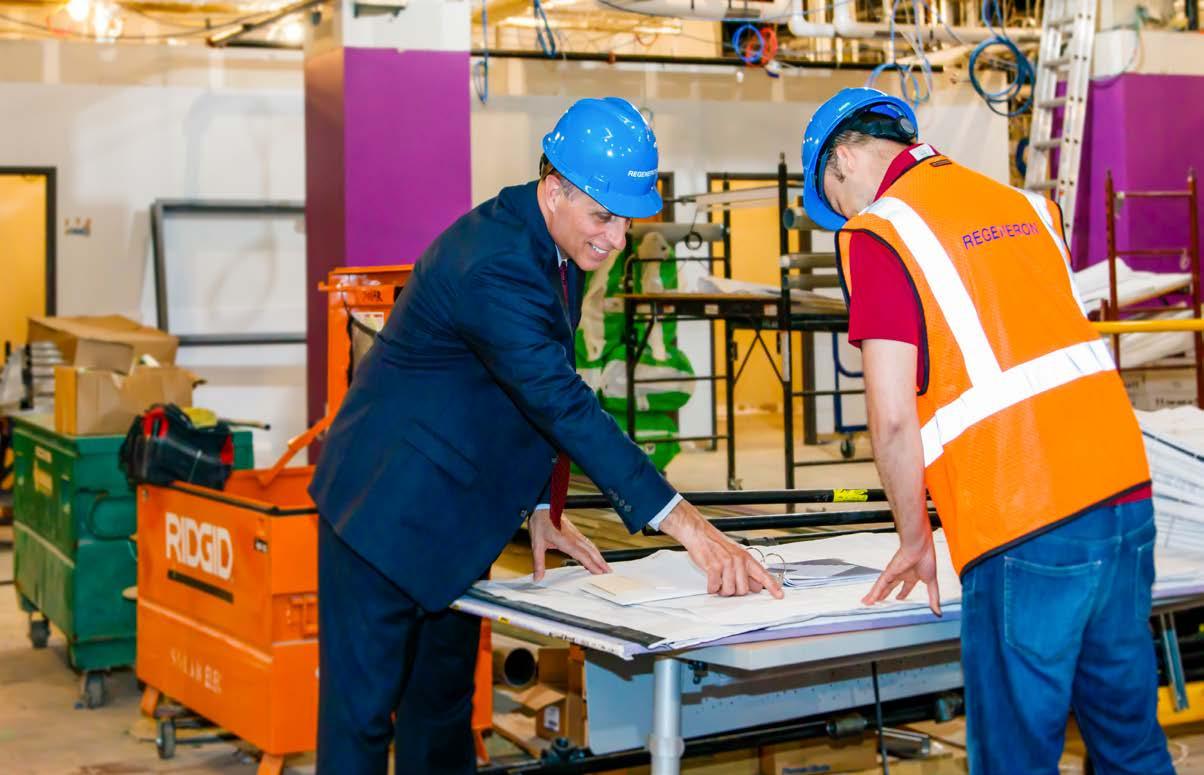
Some things have to be learned over time. As Poth now advocates, gathering employee input can lead to a hybrid of solutions. The company has a fully modern mix of collaborative and private spaces that include phone booth and meeting pods as well as sit-stand desks. Poth himself doesn’t have a door on his own office. Many interior glass walls throughout the space are designed to admit natural lighting into the space.
“This is based on our culture,” he says, which is clearly no small thing.
70 FRAMEWORK
LeChase : For over 75 years, our drive to be the premier provider of construction services has inspired us to aim for perfection in everything we do. Our team of skilled professionals has earned a reputation for integrity, quality, and safety—and for building partnerships across the tristate area. Learn more: lechase.com.
George Poth manages 1.9 million square feet of the Regeneron’s office and research facilities.
Courtesy of Regeneron


Real Estate Services Look beyond the immediate to see what’s coming next. Wherever you are, we can make sure that you’re in touch with the future of real estate. AMBITIONunlimited jll.com Jones Lang LaSalle Americas, Inc., a Maryland Corporation Jones Lang LaSalle Brokerage, Inc., a Texas Corporation © 2019 Jones Lang LaSalle IP, Inc. All rights reserved. 330 Madison Avenue New York, NY 10017
Creating a New Nostalgia

72 FRAMEWORK
Joe Bryant
By

FRAMEWORK 73
As Theresa Joy Hannig and her design team move Williams-Sonoma into new territory, they channel the power of sensory memories to offer a shopping experience
KC Esper
When Theresa Joy Hannig joined Williams-Sonoma as a store design intern in 2011, she was immediately immersed in a well-known world with its familiarity tracing all the way back to her childhood: “It was my favorite store to go to when I was a kid—the smells, tastes, and cool kitchen gadgets.” Now, eight years since her start date, Joy Hannig has flourished from that long-standing passion to become vice president of store design, leading the design team as they support Williams-Sonoma in expanding to new global markets and developing as an omni-channel enterprise.
That sense of nostalgia that Joy Hannig has felt since her early days of shopping at the company are part of what drive other loyal customers to visit each chain, which has since expanded to over 600 locations worldwide. Melissa Saltsgaver of Signtech Electrical Advertising acknowledges this as well, saying, “Although Williams-Sonoma’s brands are highly well-known, the signage identifies them, and will be what newer customers will come to recognize. It is the importance of brand recognition and a parallel line of exceptional customer experience that drives our team at Signtech.”
Since its establishment, the home goods giant has been tapping into experiential retail initiatives that seek to enhance the way customers interact and remember each store visit. “Each of our stores is the essence of the brand brought to life in a sensory and physical experience,” Joy Hannig explains. Regardless of whether customers purchase items online, through a catalog, or in-store, Williams-Sonoma ensures that every shopping experience tantalizes the senses and evokes warm memories, allowing customers to feel welcome and inspired to craft their dream homes.
Each store location is decorated with unique items that host sentimental value relevant to specific geographies from floor to ceiling. Not to mention, WilliamsSonoma is ranked number 23 of the most sustainable Fortune 500 companies, and number one for home retailers, inspiring them to incorporate reused and environmentally friendly objects in both their designs and their goods. When customers walk into a store, they see walls adorned with reclaimed wood from
historic landmarks, designs inspired by native artists, and taste samples that highlight local flavors. Their flagship store in Manhattan even features reclaimed ipe, a type of wood from the Rockaway Boardwalk that fell during Hurricane Sandy.
While the stores tap into geographically deep-rooted tradition, the design team also recognizes the need to adapt to the way these communities evolve. Joy Hannig says, “Our mission statement is to ‘enhance the quality of our customer’s lives at home.’ The store design needs to continue to evolve and adapt just as the way people live in their homes changes.”
As Williams-Sonoma expands its brands across the globe, this “home away from home” mentality will likewise extend across seas. In 2019, the company aimed to open three additional stores in Mexico and six new stores in India—to start, a West Elm, a Pottery Barn, and a Pottery Barn Kids in Delhi and Mumbai.

74 FRAMEWORK
The Rejuvenation shop in Houston, TX, offers handcrafted lighting and furniture with designs that span decades of styles.
Joe Bryant
Last year, Williams-Sonoma drew up plans for a five-story flagship to open in Nonhyeondong, South Korea.

The Texas-based Rejuvenation shop sources many of its vintage pieces from nearby antique fair Round Top.

FRAMEWORK 75
Top to bottom: Zebra Architects, Joe Bryant
Lingle Design Group works with a wide variety of clients. Each project is an opportunity for us to assist clients with creative and pragmatic solutions. Lingle Design Group’s (LDG) services include surveys, interior design, renderings, branding, new concept/remodel rollouts and construction documents primarily for quick-casual restaurant and retail clients. We are licensed in all 50 states and proudly serve clients ranging from new start-up concepts to large scale national/ international brands. For more information, please call (815) 369-9155 or email mpuckett@lingledesign.com.

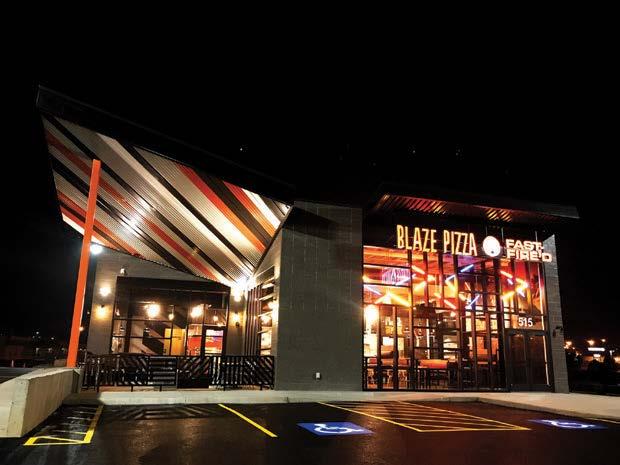
Joy Hannig envisions the stores to follow WilliamsSonoma’s sustainability focus as her design team explores ways to incorporate reclaimed wood and repurposed railroad ties.

While Williams-Sonoma was introduced to Mexico’s market in 2015, India’s market provides a different challenge. “Each store is an announcement of our brand to a completely new market, so many people have never met us before,” Joy Hannig says. “Where we show up is just as important as how we show up.”
Because India is entirely new territory for the multinational brand, Joy Hannig explains how launching the brands comes with an added layer of complexity with regards to sourcing materials and guaranteeing a good first impression among its audience. As she works with her team to develop an appropriate look and feel for each new store, she constantly brainstorms ways to highlight locally relevant designs while still communicating Williams-Sonoma’s strong brand identity. Luckily, her small but mighty team of four is up for the challenge.
Joy Hannig says that though her team is a lot busier with the new work of navigating the challenges that come with expanding abroad, the dynamic hasn’t changed. “My team is extremely lean, but strong,” she says. “They do an amazing task of juggling so many tasks at once. We’re all very fast-paced, collaborative, and aligned in the same efforts. I feel lucky to come into work each day with them there.”
Though her team is comprised of true multitasking powerhouses, over time, they’ve learned to leverage consultants and vendors to take work off their plate, allowing for better prioritization and focus on their evolving brands. In the upcoming months, Joy Hannig hopes to make spending time with her team a priority in her agenda, despite her “crazy travel schedule,” to help them grow and achieve their goals. Alongside her team, she hopes to continue sparking innovation to “make every store feel special and new.”
While constantly innovating and evolving may seem difficult, Joy Hannig’s advice is simple: just pay attention. “Our designs are influenced by so many different functional and aesthetic items,” she says, “It’s important to just stop to listen and observe the world around us.” For Joy Hannig, opening her mind to new ideas means practicing yoga and traveling the world to check out and be inspired by interesting buildings, stores, and restaurants. Luckily, for the design-centric company, Joy Hannig and her team of passionate planners follow this advice daily to harmoniously support Williams-Sonoma’s mission of enhancing homes, wherever they are.

76 FRAMEWORK
Stephen Kui
Theresa Joy Hannig VP, Store Design Williams-Sonoma
Section 03: Spaces
Exploring new and renovated facilities across the industry, from buildings to work spaces, along with the people and companies behind these projects
SPACES 77
Pave Pave
the

78 SPACES
Sakeenah Saleem,
Arenson
Way
Anthony Morin helps introduce new sites and training programs at Crestron Electronics that will impact the company’s future
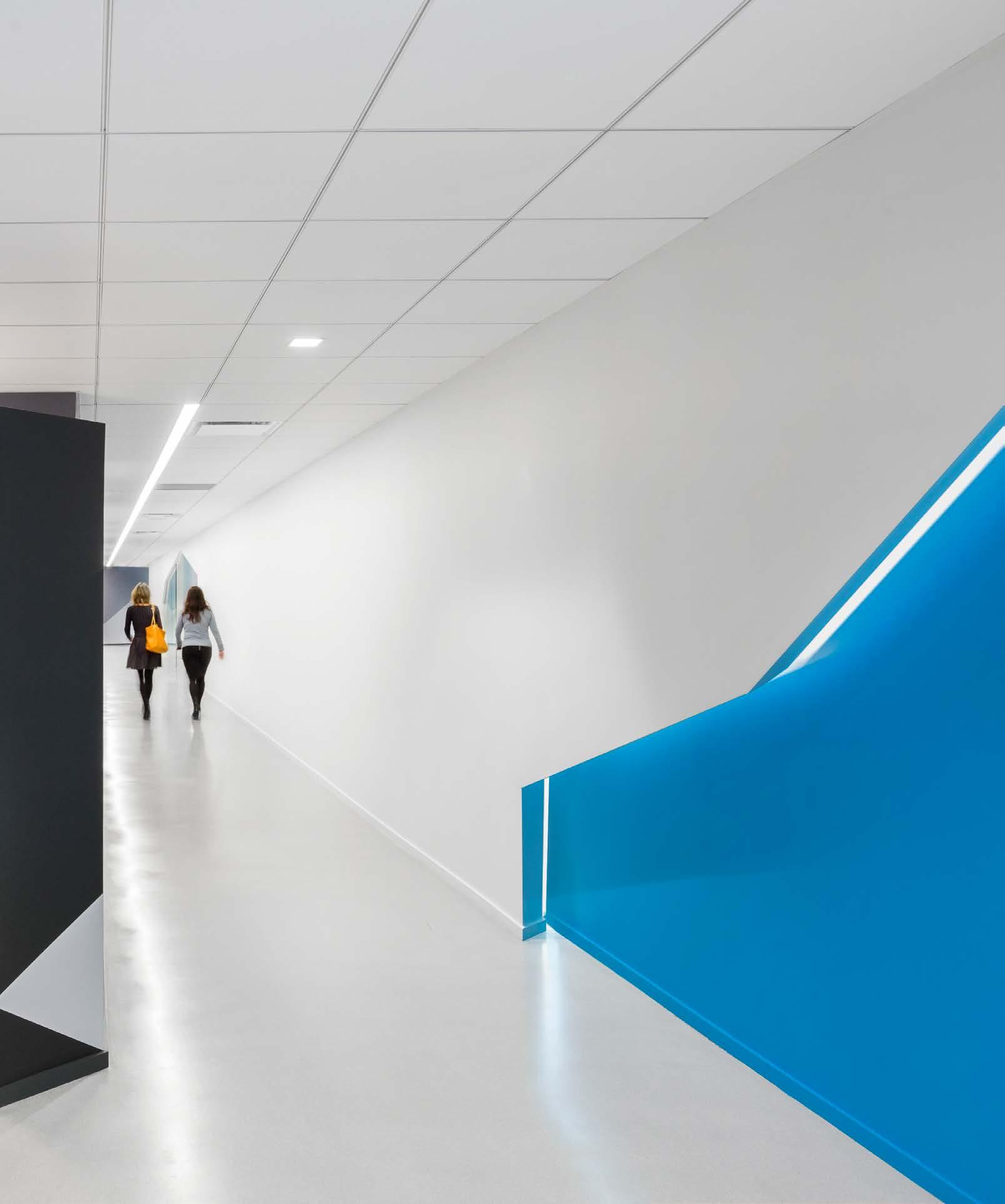 By Billy Yost
By Billy Yost
SPACES 79
It’s difficult to rate the magnitude of positive impact Anthony Morin is making at Crestron Electronics. When Morin spoke with American Builders Quarterly back in 2017, he had managed and overseen the completion of Crestron’s on-campus LifeCenter wellness facility, introduced a new healthy food service program, and was in the process of developing a master plan for the company’s headquarter campus while also constructing a new multiuse facility in Bangalore, India.

Less than three years later, Morin has far more to report, including the consolidation of Crestron’s manufacturing and supply chain functions (MS&C) into one state-of-the-art location at the company’s Orangeburg, New York, site; the completion and continued development of Crestron’s training institute (CTI) campuses first in Rockleigh, New Jersey, and now in Plano, Texas; and the continuation of major changes to Crestron’s corporate environments both domestically and abroad.
One of these projects would be enough to help define the career of Crestron’s vice president of global real estate and facilities, but Morin says he’s only “about halfway” into a transformation at Crestron that is positively impacting the company from C-suite to production line.
Training Up the Best
“One of the biggest successes really has to be our CTI projects,” Morin says. “In terms of design and the coordination involved, it really has been a unique process.” The amount of back end work, particularly from an AV component, made it imperative to work closely with internal design experts, engineering, and customer support to ensure that Crestron trainees would receive the industry’s best training experience.
The second CTI site was recently completed in Plano, Texas, and Morin says the changes that Crestron has initiated will be felt globally. Two new CTI sites are already planned for Europe, and Morin believes the training institutes mark a new era in advanced training for the audiovisual industry that only Crestron can successfully provide and sustain.
Home Base
At the end of May 2019, Crestron successfully consolidated its manufacturing and supply chain organization in New Jersey from three separate locations into a 200,000-square-foot manufacturing/logistics center in Orangeburg, New York, and a brand new 90,000-square-foot distribution center in Euless, Texas.
In Orangeburg, half of the space is dedicated to a cutting-edge manufacturing facility that features the North American debut of Panasonic’s newest electronic component mounting equipment. “This is one of the biggest real estate projects we’ve ever completed throughout the history of the company that will ultimately impact production efficiencies and our overall space utilization,” Morin says. “To provide a single source of operation for our MS&C team is something our CEO Randy Klein views as a positive enhancement to our current model of production.”
The VP says the efficiencies that are being created in the new site go far beyond dollars and cents and make the challenging and monster-scale project absolutely worth it. “The list of people who have made this project successful is so long, I’m not sure we could ever get through it,” Morin says. “Everybody from our CEO down to the person on the production line has been part of this process, and I believe that will show.”
Smart Spaces
The technological and enterprise resources required for such audacious transformations are extensive, but luckily Crestron has someone in the pipeline for that. Nic Milani, executive director of commercial product marketing, describes Crestron’s own new Flex product line with a “physician, heal thyself” mentality. The Flex platform unifies communication through Microsoft and Skype and provides optimal video and audio solutions. “We want to create a very easy and consistent experience for our employees as they’re moving around these new spaces and can quickly connect with clients and each other,” Milani says.
Crestron’s scheduling platforms include panels outside of meeting rooms with colors that will change
80 SPACES
Oleg March
Anthony Morin Vice President, Global Real Estate & Facilities Crestron Electronics
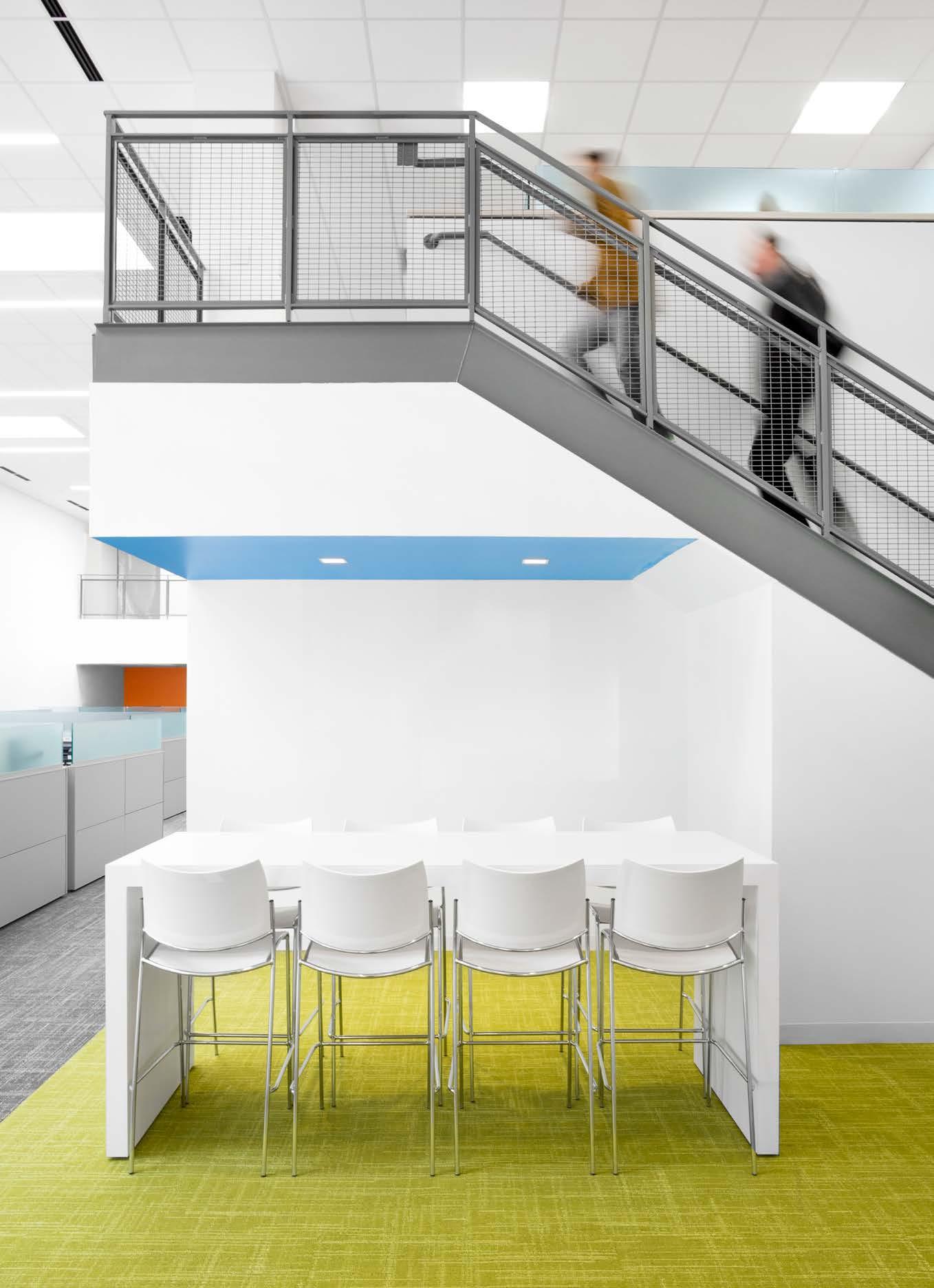
SPACES 81
Workers ascend the stairs in the marketing area of the Rockleigh, NJ, campus.
Sakeenah Saleem, Arenson
from green to red when a meeting is in progress and where ad-hoc booking can be done at-will. The room also recognizes if a scheduled meeting isn’t happening and returns it to inventory. “It gives you the ability, from a real estate standpoint, to really optimize the usage of your rooms,” Milani says.
All of these systems and platforms tie back into XiO Cloud, a service that earned it IoT Partner of the Year by Microsoft, and whose capabilities allow monitoring of all inputs as well as automatic firmware that is aptly illustrated by Milani succinctly explaining the process of connecting a new piece of technology: “It just starts to work.”

A Self-Imposed Revolution
While Morin is aware of the impact he has been tasked with implementing, he knows successful outcomes are a group effort, and has experienced
82 SPACES
Oleg March
“Everybody from our CEO down to the person on the production line has been part of this process, and I believe that will show.”
In May 2019, Crestron unveiled its 200,000 square-foot manufacturing/ logistics center in Orangeburg, NY.


Rockleigh campus features an exclusive training center.
the most meaningful result of all the hard work when speaking with a member of his own team.
“One of my team members is finally able to take a vacation after completing the Orangeburg project, and he says to me with excitement that he is going to drive his kids up to the building to show them the project he was tasked with managing,” Morin says. “He’s been outstanding and to find out that he wants to show off his work to his kids—I can’t really ask for much more.”
That said, the VP continues to look at how the change he’s helping drive will impact Crestron five years down the line. “I want to make sure we stay relevant and continue to enhance,” Morin says. “I’m never looking to settle.”
work with businesses
institutions of all sizes, ranging from small start-ups in temporary office space to large corporations with numerous locations around the country and around the globe.

We believe that service exists in the details. Because of this, we have developed a comprehensive set of in-house products and services for commercial interiors, minimizing the use of subcontracted vendors.
We incorporate a consultative approach to holistically address all aspects of the furniture and interiors life cycle. 100 percent project control and 100 percent accountability translate into lower costs for our clients and fewer problems from start to finish.
Carl R. Milianta Arenson Office Furnishings President

SPACES 83 Aramark proudly supports CRESTRON and over 170,000 other market innovators For more information, please visit www.aramarkrefreshments.com ©2019 Aramark. All rights reserved. COFFEE | WATER | MICROMARKETS | SNACKS
We
and
The
Sakeenah Saleem, Arenson
Fuel for Growth
Heather Clark has led Walmart’s remarkable venture into fuel and convenience
By Billy Yost
In just four years, Walmart expanded its emerging fuel operation from 10 to 400 gas and convenience locations. Initially, there was only one person who was tasked with spearheading this growth as her sole responsibility.

Meet Heather Clark, whose role was to not only develop the new line of business for the superstore powerhouse, but also find a way to grow the business at the speed of an organization that prides itself on the ability to think big. Clark says it was a master class in working cross-functionally and in learning to lead a team whose scope was much larger than just the fuel business. The senior director of fuel development and construction admittedly knew nothing about fuel before taking on her role, but is now also overseeing development,
construction, marketing, prototype design, maintenance and repairs, and a whole slew of other responsibilities that she has learned on the fly and from a team that she says she couldn’t be successful without. Clark says she loves being challenged, and it’s a good thing, as she continues to demonstrate a willingness to take on roles for which her own experience is somewhat limited. The senior director has spent the entirety of her career thus far at Walmart but in a scope of incredibly varied roles. After realizing that transactional work on the real estate side wasn’t for her, she elected to continue her theme of learning by doing and take a leap into construction project management. “I had zero experience leading people, working in construction, or
84 SPACES

SPACES 85
Mitchell Communications Group
project management,” Clark notes with a laugh. “But I learned that I loved leading people and seeing the tangible impact we were making on the business.”
The company noticed Clark’s propensity for being a fast learner, and ultimately asked for her assistance getting Walmart deeper into the fuel and convenience business. “That’s one of the amazing things about working here,” Clark says. “If you work hard and prove yourself, the leadership will give you a chance to do almost anything.”

As the sole individual dedicated to the build-out, Clark had to find expertise wherever she could, which meant borrowing resources from all different parts of the company, ranging from merchandising to operations to HR. The tough part, she recalls, was that the people involved were already engrossed in their primary roles with scales and scopes that were much larger than launching this new, smaller line of business.
While Clark says the business had to learn from mistakes early on, the 10-to-400 ballooning of fuel and convenience locations is an unmitigated victory for the director. It also led to Clark being asked to take on design and construction for the two largest Walmart
Heather Clark
Senior Director of Fuel Development & Construction
86 SPACES
Walmart
“We created a whole new way of working due to all the changes we wanted to implement.”
Courtesy of Walmart
format fuel stations in Crowley, Texas, and Rogers, Arkansas. “We did everything from selecting the sites to designing the prototypes to developing the internal and external features, and working to greatly expand our customer offerings,” Clark says. “We created a whole new way of working due to all the changes we wanted to implement.”

Six months is generally the time it might take to agree on potential blueprints, cobble together a team, or narrow down location sites. Six months for Clark was the length of time from initial impetus to move forward with the project to the opening of these two superconvenience locations. The director isn’t particularly fazed by the shocking speed of execution, only complimentary of the “army” of people that it took to make it happen. “It took a lot of very dedicated people pushing as hard as they could,” Clark says. “We continue to learn from this, and it has taught us more than we thought was possible about running a convenience store.”

Clark says that after the blitz of expansion, the organization is now working to better customize its offerings for locations that are virtually everywhere in America. “Montana and South Texas don’t have the same tastes, so we’re working to tailor our offerings to the region and better serve our customers,” Clark says. It’s also meant not only adjusting the fuel marketing program but creating it—and going public. “For the first two years, we weren’t really even telling people that we’re in the fuel business, so now we’re trying to get the word out about what we do and how great of a value our customers can get by shopping with us.”
As Clark continues to grow into her new responsibilities, she says she’s currently staffed with the best team she’s ever had. “Great teamwork makes me happier than almost anything else,” Clark admits. “My team fills in gaps even if it’s not their responsibility or area of expertise.” It’s essential for an organization that continues to develop increasingly diverse lines of business, and Clark’s own capacity to do just about anything seems to be contagious.
While the director says no one at Walmart spends too much time dwelling on past success, she is incredibly proud any time she sees customers entering a space that she has helped create. “There’s really nothing comparable to the experience of walking into a station or store and seeing customers interact with what you’ve tried to give them.”


Delivering Your Brand Promise Retail strategy, design, print, fixtures and digital execution for customer-centric experiences. millerzell.com millerzellatl @millerzell miller-zell
The Science of Possibility
Sean McFaul sparks life science innovation with a novel program that literally gives space to new ideas

88 SPACES
As Told To KC Esper Courtesy of Vertex Pharmaceuticals
I don’t have the typical background for someone who works in my field; in fact, I’ve been in risk management and insurance for most of my career, which for me really had little to do with real estate and certainly nothing to do directly with being on a lab bench doing chemistry.
When I transitioned into my real estate role at Vertex, I was working on an enterprise business continuity program that provided a bridge to my new team. It explored key functional areas in different divisions within the company, asking basic questions about what they do, how they do it, what it would look like if they couldn’t operate at an affected location, and so forth. It required me to interview subject matter experts
to understand more about their roles from our earliest stage of research to our patient services group that offers personalized support to patients who have been prescribed our medicines.
It was like a mini MBA in pharma or biotech—I learned more in six months than I ever could have in years.
At Vertex, drug development is the ultimate team sport; it’s extraordinarily complex. In 2011, we went through a rapid transformation with the approval of our first real “blockbuster” commercial drug for Hepatitis C. That discovery allowed us to grow quickly, which was fantastic, but it also required us to think about how large our real estate footprint was. At this time, we had been in 10 different buildings in Cambridge near Boston.
Some of Vertex’s lab space is dedicated for use by local high school students, who could later be recruited by the company.
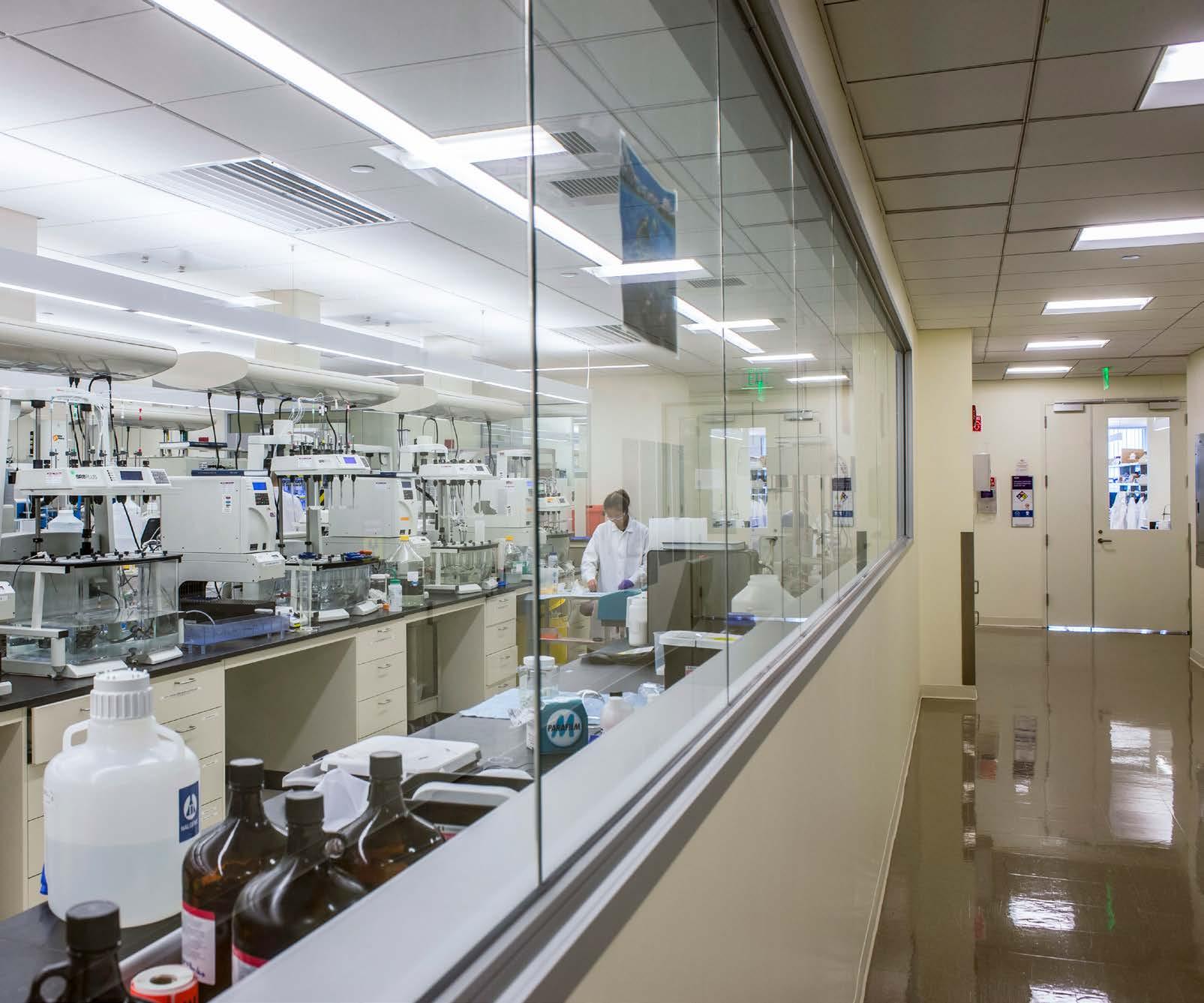
SPACES 89
Shared Brainpower
After transitioning to real estate, Sean McFaul discovered a noticeable gap between himself and the people he had networked with during his time working on enterprise business continuity. He wanted a platform where senior and executive directors could connect and learn from each other to strengthen their leadership development, which inspired the 1213 Knowledge Exchange program.

The 1213 meets monthly to offer mentorship and open dialogues between senior directors. The program connects cross-functional leaders to facilitate better teamwork, innovation, and one of Vertex’s core corporate values: “We” Wins.
Eventually, we decided to consolidate the organization and move to an underdeveloped area of Boston known as the Seaport. When we arrived, we were at approximately 60 percent of the 1 million square feet of capacity, and we’ve grown to occupy just over 80 percent today.
This year we’ve begun working to drive a new wave of workplace strategy planning so our environment can be highly reflective of our culture and provide space to match our growth. We’re making sure we’re being innovative with our design and that we can deliver employees the choices to allow them to be their best selves and do their best work while they’re here.
These efforts point to ways we can use space wisely and be a highly productive workforce, but we also wanted to develop something that allowed researchers to come together and create. Cultivating innovation was the major driving force for our incubator program, HubLab.
HubLab is space in our Boston headquarters that we’ve dedicated to small biotech startups who need a place to launch and grow their companies. Typically, tenants are early-stage research companies working on novel drug discovery programs or technologies. We offer them short-term leases below market value in an effort to grow the biotech ecosystem here in the Seaport.
90 SPACES
Sean McFaul Senior Director of Global Real Estate
Vertex Pharmaceuticals
Courtesy of Vertex Pharmaceuticals
Vertex’s $800 million headquarters is situated on the South Boston Waterfront.

The space features swivel chairs and pillows decorated with elements from the periodic table.

SPACES 91
Joseph
P. Murphy (Top), Courtesy of Vertex Pharmaceuticals (Bottom)
Before the Hub Lab concept could be implemented, a multi-disciplinary team of internal and external experts were convened to discuss key matters regarding potential risks and the operational logistics of non-Vertex companies operating in our headquarters. Since we lease the facilities where Hub Lab operates, our landlord needed to understand the program as well. It took about nine months to align all of the stakeholders and develop the operational plans and contractual documents to bring our first tenant in. We’ve learned something with every tenant that has come into our program and continue to work towards perfecting the model to position them for success.
Not only are we pioneers on the scientific side of our business, but also in terms of our corporate vision for how Boston was going to develop and how we could innovate in all aspects of our business and the community. HubLab fit perfectly into that vision. We were the first major pharma company to come to this part of Boston, but we certainly don’t want to be the last. Researchers can rent a space in HubLab for less than the steep market rate. To bring innovation to the Seaport, we created this program in a way that acts less like a landlord, and more like a ward of the next wave of scientific innovation. The Vertex Hub Lab team is very proud that we not only support our internal science and breakthrough therapies, but also other drug discovery platforms and therapeutic areas that will hopefully provide solutions to unmet medical needs.
Since we started the incubator program, we’ve seen incredible success from our partners. Our first partner was recognized by a publication that releases an Courtesy of Vertex
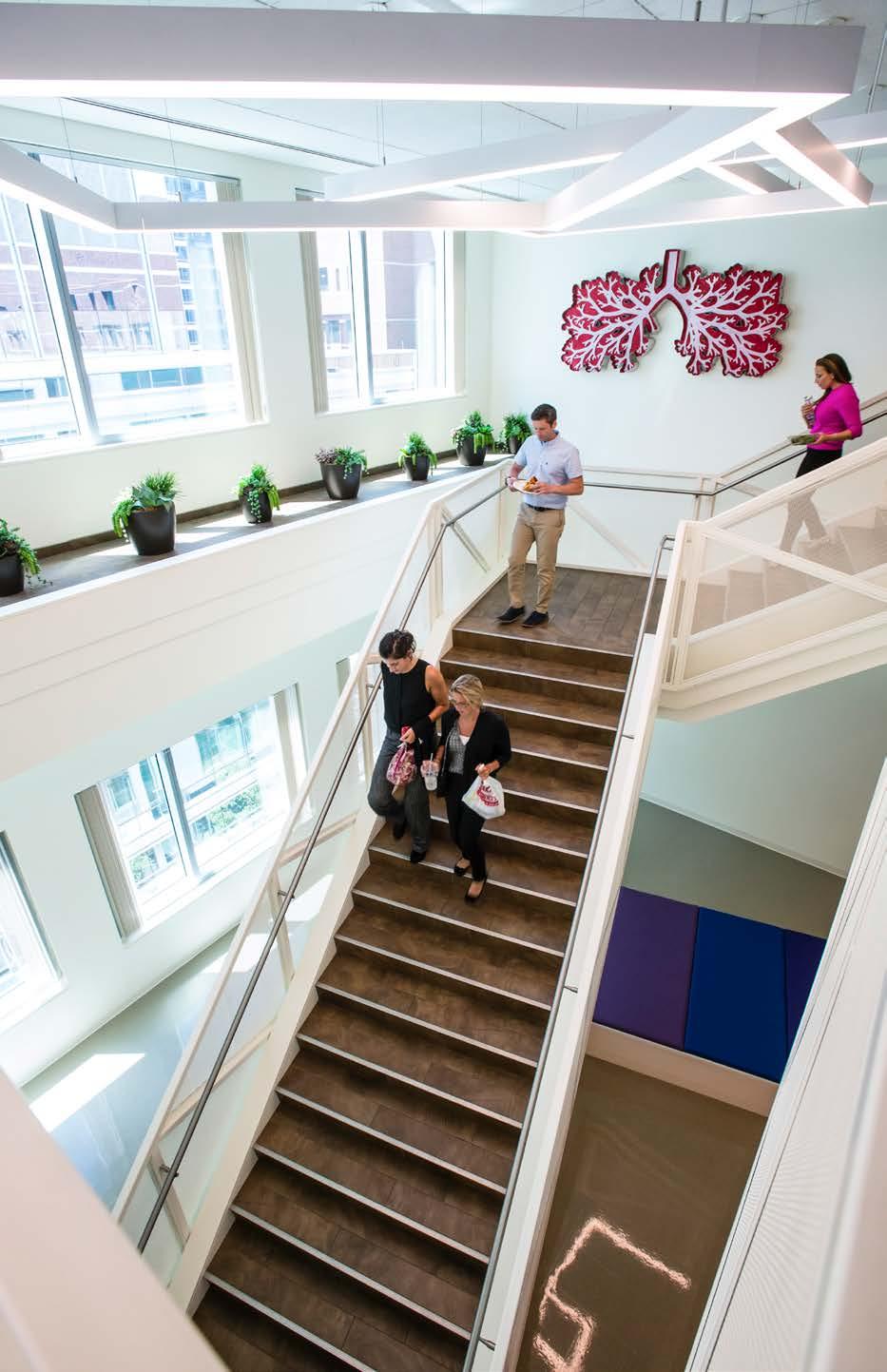
92 SPACES
Pharmaceuticals
The upstairs office space is flooded with natural light.
annual list of the top innovative companies or companies that they think will be successful in the future. Now, they’ve moved into a larger space within our building and have grown from a handful of employees to over 30. This diversity of thought that our partners bring to our neighborhood and workplace has also strengthened our culture of collaboration and helps us to spark novel ideas in the Seaport.
Hub Lab is a great example of how all parts of Vertex can help to achieve what we call our “Science of Possibility.” We’ve built an amazing team here and it is awesome to be a part of a group that is developing inventive space options for the future of life science innovation. The team has embodied our core values— “We” Wins, Innovation Is Our Lifeblood, and Fearless Pursuit of Excellence—in building Hub Lab to what it is today. I can’t wait for what comes next.
CBRE values our relationship with Vertex Pharmaceuticals, Inc., and we thank Sean for sharing his talents with our firm. It is our mission to provide the highest quality of professional service to meet the needs of our diverse client base. To learn more about the firm, visit cbre.us.
CBRE’S
BOSTON CONSULTING IS A PROUD PARTNER OF VERTEX PHARMACEUTICALS INC.

Through comprehensive consulting services that drive innovation, CBRE assisted Vertex in creating new possibilities. Our holistic approach and nimble platform maximize the real estate strategies that transform ideas into reality—like Vertex’s cutting-edge incubator project. That’s advantage delivered.

cbre.us/boston
BREAK THROUGH WITH BOWDITCH
Bowditch is proud to partner with Sean McFaul and Vertex Pharmaceuticals on their Hub Labs project and wish the team continued success.
New England and Beyond BOWDITCH.COM
| GROUND
Development project parties, investors, property owners, and tenants rely on Bowditch & Dewey’s real estate, environmental law, and construction attorneys to help them break ground. We deliver outstanding client satisfaction and bigfirm quality legal services. Break Through with Bowditch. Visit bowditch.com.
BREAKING
A Philosophy to Construct Greatness
Guided by a personal vision for strong leadership, Nick Williams is tackling big builds for C&S Wholesale Grocers
By Stephanie Zeilenga
94 SPACES

SPACES 95
Ben Steiner
The C&S Wholesale Grocers’ culture is built on nourishing communities, from warehouse belt to grocery store belt.
Nick Williams carries copies of his leadership philosophy with him everywhere he goes. He has a copy framed in his office, and he references it when he interviews prospective employees. It’s a living document, revisited and revised at each year’s end. Neatly laid out on a single sheet of paper, his philosophy includes a bulleted list of how he believes a leader should act as well as what he feels are his gaps in living up to those expectations as vice president of engineering and construction at C&S Wholesale Grocers, a leading food supply chain company and the largest wholesale grocery supply firm in the US.
“I played sports growing up right through college and was a goal-driven individual, but when it came to my career, I had never identified what leadership meant to me and how I expected to hold myself accountable for what I believed in,” Williams says. After six months of revisions in 2014, he shared his philosophy with every single person under his umbrella at C&S, from his direct reports to the nighttime janitorial team members. “It doesn’t mean anything if it just sits with you,” he
explains. “I’m asking everyone on my team to hold me accountable. If they see me not living up to my values, they’re free to call me out on it.”
Likewise, Williams preaches what he practices so his team understands the importance of these methods, stressing that communication, delegation, and accountability are keys for success. “Communication is critical, and it starts with the individual,” he explains. He notes that feedback should be both positive and negative, allowing the recipient to react and reprioritize when necessary. “At that point, you then need to delegate, and that delegation could be something you have to own, or someone on my team or their team needs to own.” Then, he adds, you need to hold yourself or them accountable.
Another one of his values is that a leader creates “a safe environment where everyone knows that their voice can be heard and risk-taking is discussed.” Since rising in the ranks at C&S, Williams has put a lot of intention behind cultivating the inclusive and open work environment his philosophy dictates. This has proven an invaluable asset as C&S has grown rapidly in recent years, expanding through both acquisition and

96 SPACES
Nick Williams
Vice President, Engineering & Construction
C&S Wholesale Grocers
Ben Steiner
C&S supplies more than 14,000 independent supermarkets and institutions with over 140,000 different products.

SPACES 97
organic growth. Williams’s team of 53, which oversees a little more than 22 million square feet of warehouse space and handles all of the primary engineering and design functions from conceptual site and building layouts to electric, fire, mechanical, and refrigeration, has played a key role. Beyond that, Williams chaperones the company’s computer asset management system, an IBM product called Maximo, and the analytics and procurement of all material handling equipment (MHE). “We’re constantly balancing day-to-day firefighting against executing on our strategic vision as we move from preventive to predictive maintenance,” Williams says.
Achieving this balance between immediate needs and future company expansion requires a nimble, hard-working team. “I expect a lot and provide guidance, but I ultimately let them have ownership over their work,” Williams says. “They know I have their backs and I’m going to support them no matter what hurdles arise. Ultimately, they know everything I am trying to accomplish is in the best interest of each employee, our department, and our entire organization.”
Williams’s leadership philosophy says leaders develop relationships with team members. He does this enthusiastically, working to schedule time with as many
members on his team as he can. It’s all rooted in respect, he notes. “My dad taught me to respect the CEO just the same as the guy sweeping the floors. I know that’s wicked cliché to say, but that’s how I try to lead. Every person matters on our team for us to be successful.”
This tactic has the added benefit of helping his team operate seamlessly as they juggle a heavy load of responsibilities and pull off major projects, such as their latest: the construction of a greenfield warehouse in Houston that was completed in the summer of 2019. The 727,000-square-foot grocery distribution center sits on 54 acres and includes parking for nearly 600 cars, 154 tractors, and 293 trailers. It also includes two outbuildings, a 20,000-square-foot stripping building, and a 25,000-square-foot fleet maintenance building with a central dispatch for supply chain logistics as well as maintenance bays for tractors and trailers, a truck wash, and diesel fuel lanes. While the Houston facility was underway, Williams and his team were concurrently responsible for decommissioning 10 dry space buildings totaling close to 3 million square feet as part of the overall southwest strategic plan—a lengthy, complex process. Additionally, while the Houston strategy was being executed, his team had two major renovations of existing operating facilities in the south- Ben

98 SPACES
Steiner
C&S Wholesale Grocers is the largest wholesale grocery supply company in the US.
east region, where they were responsible for turning approximately 100,000 square feet of dry grocery into a cooler, perishable space and subsequently turning the perishable space into freezers.
Building the Houston facility was a unique oppor tunity for Williams, who more typically manages reno vations tied to the company’s capital plan. “Houston is our pride and joy,” he says. “Our organization hasn’t done many projects of this magnitude in recent years, but we were able to pull it off because of the trust I’ve cultivated and our ‘one team’ mentality.”

All of this was completed without adding to his team’s ranks. “We’ve got a lot of grit, and we love the challenge,” Williams says. “At the end of the day, we’re a customer service department. We know it’s a luxury to have our own engineering and construction team.”
Williams loves the work, but he loves his team even more. “I look outside my office and see men and women I appreciate getting to work with every day,” he says. “It makes my job worth coming to, and they’re why I get up in the morning and continue to hold myself account able. We spend a lot of time together, whether we’re on the road or working from our home base. We enjoy rolling up our sleeves and getting things done.”

SPACES 99
www.r717.net
Cintas congratulates Nick Williams for his recognition by American Builders. We are proud to help C&S Wholesale Grocers get Ready for the Workday® by providing products and services that enhance their image and help keep their facilities and employees clean, safe, and looking their best.
“I’m asking everyone on my team to hold me accountable. If they see me not living up to my values, they’re free to call me out on it.”
Less Is More
Despite a need to consolidate Lenovo’s offices,
 By Lior Phillips
By Lior Phillips
When Lenovo went through a large acquisition in 2014, acquiring IBM’s x86 server business encompassing about 1,500 employees in both office and hardware development labs, Director of Global Real Estate Deidre Buzzetto had only six months to find them space in or near Lenovo’s Raleigh, North Carolina, headquarters. Having worked at IBM for 15 years and Lenovo for another decade, Buzzetto had been through more than her fair share of acquisitions.
“In fact, when Lenovo acquired the PC business of IBM, I was not part of that acquisition, but I knew they didn’t have anybody for real estate in Lenovo and decided to go over,” Buzzetto says. In addition to the hundreds of employees, the 2014 acquisition involved complex data centers, server labs, supply chain, and the new Data Center Group headquarters staff. The task was daunting—and then Lenovo added another
acquisition in the form of Motorola Mobility Group, and Buzzetto knew she’d have a much larger job on her hands.
“We’ve been working and consolidating over the years, so we don’t have more than one location in a city or even a country. As we looked at our utilization sitting between 50 and 60 percent, we needed to look into how we could utilize our space more effectively,” Buzzetto says. She found that Lenovo’s global infrastructure might be the reason for the inefficient use of space, granting her an opportunity to rethink usage in its new offices.
Lenovo, in fact, decided—once the acquisition was in place—to next consolidate from two Raleigh campuses to one. That decision hinged clearly on adjustability. “We’re a flexible company,” Buzzetto says. As the workplace transformation process began,
100 SPACES
Deidre Buzzetto and her team discovered ways to maximize the effectiveness of the space they do have

SPACES 101 Storr Office Environments
Lenovo features a “front porch” with soft seating options.
Buzzetto and her team worked with companies such as sustainability consultants Altanova to build the smartest workplace possible that could adapt with the needs of Lenovo employees. One major part of that process is getting ahead of the curve when it comes to utilization, which Lenovo now tracks on an ongoing basis with the help of Rifiniti. For Lenovo employees, that means working in a new, flexible workspace and not having a dedicated permanent seat. This allows employees to find the spaces that are best for them, which can be collaborative spaces, huddle rooms, phone booths, or height-adjustable workstations.

Buzzetto herself knows the reality of being a mobile worker and frequently traveling as a Lenovo employee. “I sit in New York, but we don’t have an office in New York. So I’m a mobile employee, and I probably am at home two weeks out of the month and traveling the rest of the time,” she says, adding that her team is spread around the world, from Australia to Scotland to Singapore to Malaysia. The key to leading her team under those circumstances, Buzzetto notes, comes in the form of communication, which has led to most of the team working together for upward of a decade.
Additionally, the new headquarters are organized by “neighborhood,” giving teams and departments general areas where they typically congregate—though employees are encouraged to find other spaces that might suit them, depending on the day and the projects they’re working on. “If you’re going to have meetings with procurement, maybe you want to sit near
Lenovo’s dedication to fostering an environment of community and inclusion is backed by its collaborative spaces.
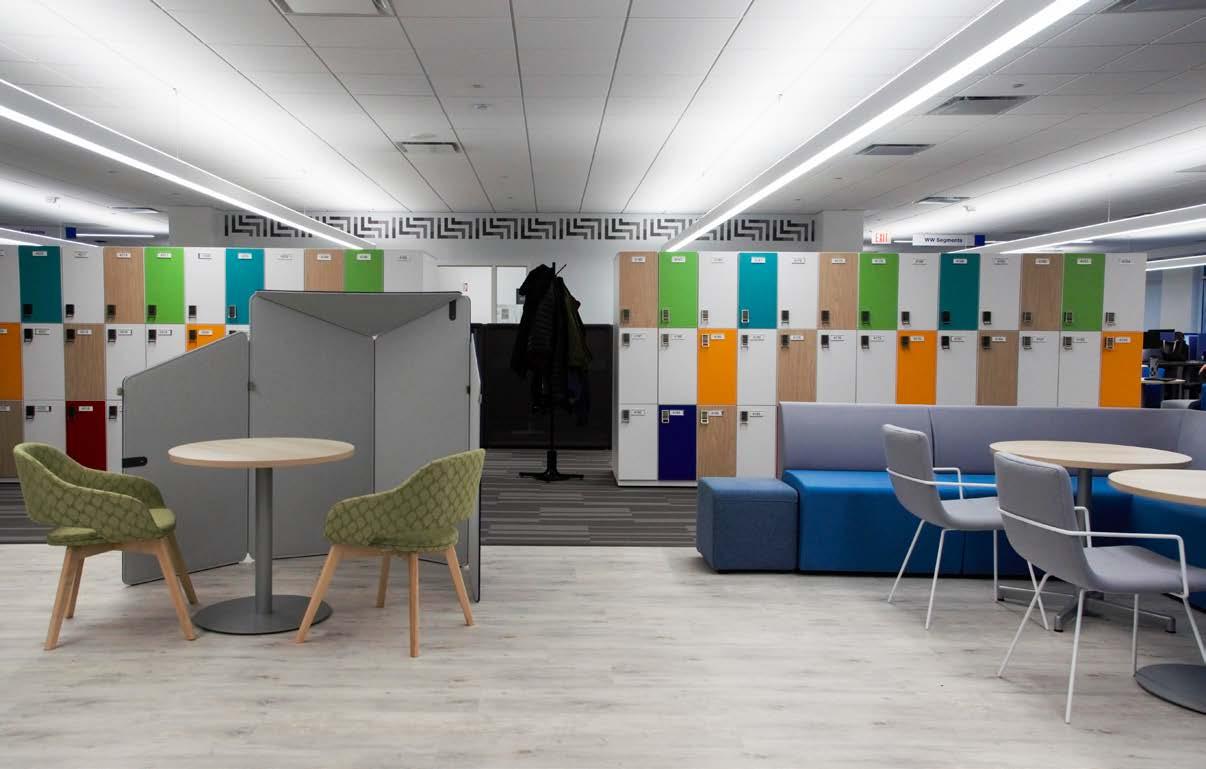
the procurement team,” Buzzetto says. These neighborhoods may incorporate phone booth–style spaces for quiet work, small café spaces with picnic tables for group work, and window benches for more relaxed options. “We wanted to provide the environment that would be best for whatever tasks those employees are doing for that day,” she says.
“We decided from there that we could make the move to consolidate our Raleigh locations, moving a thousand people into our main US campus,” Buzzetto explains. “We’re starting to utilize more and more flexible work space so that if we learn an employee needs a space in Madrid, [our partner] OfficeNetwork will go out to all the providers and be our broker for us and get this space.” Under this plan, 20 percent of Lenovo’s space is flexible workspace—and Buzzetto envisions that number growing. “That gets you up and running very quickly, and you have greater flexibility,” she says. “You’re not locked into a long-term lease.”
But even then, related factors like parking and continued improvements to comfort and accessibility became the next hurdle. As Raleigh’s public transit system is still in its budding stages, the need for parking is a massive concern for Buzzetto’s team, and a new parking structure was built. Next came redesigning the space to incorporate height-adjustable desks and add quiet spaces as well as soft furniture and improved acoustics. Buzzetto’s team planned the development of buildings on the campus based on who would be working out of them. “One building, which is Platinum
102 SPACES
Deidre Buzzetto Director, Global Real Estate Lenovo
Storr Office Environments (Project image), Courtesy of Lenovo (Portrait)

SPACES 103
“As we looked at our utilization sitting between 50 and 60 percent, we needed to look into how we could utilize our space more effectively.”
Storr Office Environments
Lenovo provides space for employees to gather casually as well as collaboratively.
LEED-certified, is dedicated to key inside sales, which is about 80 percent millennials, so we built that space with that demographic in mind,” she says.


Once spaces were built, the team had to work out educational materials to show the thousands of employees the benefits of their new space and what could still be improved. “We engaged in a workplace transformation program, which started with interviews with the senior leaders, then middle management, and then roundtables with employees,” Buzzetto says. “The final move will be people from our other campus into this location.”
And as Lenovo makes these big changes, Buzzetto has found that leadership is growing more and more excited—and employees are more and more involved with the administration. “We’re remodeling our workspaces around the world, and these flexible offices are getting people up and moving as well as actually interacting more with executives,” she says. “We’re seeing
so much more interaction and collaboration. There’s just a buzz around, and this isn’t the environment that we’d had before.”
“Deidre is one of the most forward-thinking executives in the world of corporate real estate,” says Brian Dice, CEO of OfficeNetwork, a company that specializes in providing nontraditional workplace solutions and has worked with Lenovo in the past. “She clearly understands how to harness the power of the flexible workplace and has led Lenovo to change its global real estate strategy to one that matches the company’s need for workplace agility.”
104 SPACES © 2019 Jones Lang LaSalle IP, Inc. All rights reserved. All information contained herein is from sources deemed reliable; however, no representation or warranty is made to the accuracy thereof. Congratulations, Deidre! At JLL, we’re committed to helping our clients achieve their ambitions around the world. We’re proud to partner with Deidre Buzzetto and recognize her for her many achievements at Lenovo. jll.com AMBITION
Applauding OfficeNetwork is the global leader in sourcing alternative and flexible workplace solutions for corporate real estate departments around the globe. We assist in achieving multimillion-dollar savings for our clients and work with them to establish agile and cost-effective workplace strategies.
Real Estate Services
Section 04: Portraits
Sharing stories that detail motivations, ambitions, and missions of executives in the building industry and getting a firsthand look at what they are achieving today
PORTRAITS 105
Creating
Momentum
Sandy Karp doesn’t just construct the spaces for iPic’s renowned theaters. She also constructs and supports a team of healthy, happy people.
 By Melaina K. de la Cruz
By Melaina K. de la Cruz
106 PORTRAITS
Karen Fuchs
Over a dozen artists were commissioned to create the artwork that adorns the lobby of iPic.

PORTRAITS 107
It’s eight in the morning—do you know where your boss is?
Sandy Karp’s team knows that from the morning hours of seven to ten, the time is hers. These 180 crucial minutes are spent however Karp needs to use them, from exercising to looking at plans to researching new concepts. While some might initially consider it an unconventional practice, Karp finds it essential to a productive day, and ties it directly to her leadership philosophy of allowing employees to create space for their own mental and physical wellness in order to succeed.
Karp is the vice president of construction and development for iPic Entertainment, a luxury cinema chain that sets itself apart from typical movie theater experiences by delivering what Karp herself refers to instead as “memories” for customers.
Perhaps Karp can credit both her role of curated customer satisfaction and her holistic leadership approach to her own personal experiences, beginning with an initial career as a personal trainer at the age of 18. She cites the particular transition of fitness into corporate America as pivotal to developing her current mind-set about the need for striking a balance between work and wellness: “Suddenly, the things that used to be my things that I loved, I kind of just let slide. Working long hours and having no time for yourself was celebrated by all your peers and bosses— it meant you were doing a good job!”

108 PORTRAITS
Sandy Karp Vice President of Construction & Development iPic Entertainment
Linzi Martinez

PORTRAITS 109
iPic’s Delray Beach location features a full bar.
Karen Fuchs
Theater guests can push a button to prompt “ninja servers” to bring pillows, blankets, and popcorn.

Downtown Delray’s vibrant nightlife lent itself to an ideal location for an iPic theater, providing locals with more options.

110 PORTRAITS
Karen Fuchs
However, she adds, this type of grind not only disconnects you from your hobbies, friends, and family, but it quickly leads to exertion and a false internal narrative that you simply can’t make any room for selfcare. “We tell ourselves we’re too busy to go to the gym. We travel too much. We don’t have time to eat right. We make all these excuses and they’re just not true,” Karp says. “Having no time to work out or stay connected is just noise that we create because the reality is that you’re not really effective in any area of your life.”
Karp explains that her personal wake-up moment came in the form of a difficult conversation with none other than herself. She was overworking and had fallen into a depression after a rough year rife with pressure, extensive travel, and difficult personal matters. “I looked terrible and I finally looked in the mirror and asked, ‘Who is this for?’ I work hard for my family and myself, and I’m not doing myself any service. I’d started to lose my passion.”
She began to remedy this by “going back to her roots,” and allowing herself to hit refresh on the disconnect she felt from her life, with help from her manager.

“The truth is that my boss never said to me, ‘Please don’t take time to work out. I need you to be here 60 to 70 hours a week,’” Karp says. “My boss never told me, ‘I
need you to stay in the office, so you don’t see your kids and husband before they go to bed.’ In fact, my boss told me the exact opposite. He told me not to let work interfere with my family. He knew how hard things were. He told me never to have regrets. For me, it was my job to make sure I let him know if it got to be too much.”
Now she seeks to do the same for her own team, through a variety of initiatives that range from an in-house Keto plan started by iPic’s founder to implementing community exercise programs for employees to encourage one another to sharing healthy food and fitness goals. “It’s not about just looking good; it’s about feeling good,” Karp explains. “The point is we’ve created momentum and people are jumping on board. A toxic environment is contagious but the same goes for when you create a healthy environment.”
Karp’s vision is to help her team become “positive, empowering people,” which she emphasizes is indeed a goal rather than a hope. She notes that people have been jumping on the wellness programs, and a member of her team has already lost 35 pounds, which has inspired others to follow in his footsteps.
Her unique background in training and hospitality lends itself not only to meeting these wellness goals but also to her current role at iPic, just in a different way. “I

We Build Entertainment Centers - Hospitality Retail - Commercial - Industrial - & More
Services: Construction Management - General Contracting - Design Build Preconstruction - Project Management - Construction Consulting - Site Development WWW. MARCHASSOCIATES .COM - (973)-904-0213 ipic Theater in dobbs ferry, ny
Build it Better.
Sequoia Group is a luxury millworker with the ability to execute design, development and installation. Our specialty is in complex details and competitive pricing.


get to be creative and have an opportunity to provide guests with a personalized experience,” she explains.

iPic specializes in the luxury movie theater experience, but it didn’t stop there. The company has also evolved its spaces to include international art, highend dining, and a venue for entertainment beyond movies. “We’ve recently added some state-of-the art theater lighting and sound to every site in order to accommodate things like magic and live shows,” Karp says. “It’s always great to expand your horizons and be the leader innovating new ideas.”

As the coordinator of all aspects of design and construction, from the moment she arrives in the space, Karp is passionate about the customer experience side of her work. “I get a lot of joy when my friends go to iPic for a birthday or a special event, then they tell me the details,” she says. “I know they just created a memory there, and I think it’s awesome to be part of that—to be somebody that had a part in creating that. I’m extremely grateful to be part of the whole thing. And in the end, it’s the memories that we keep forever.”
superlgroup.com
 CEO Hamid Hashemi channels the glory days of movie theaters from the ’30s and ’40s by offering luxurious accommodations such as swinging hammock chairs.
Sequoia Group
Karen Fuchs
CEO Hamid Hashemi channels the glory days of movie theaters from the ’30s and ’40s by offering luxurious accommodations such as swinging hammock chairs.
Sequoia Group
Karen Fuchs
Renovations for Relevance
Director of Construction Nathan Zimmer is in the midst of hundreds of renovations for First Watch restaurants, but he’s already planning for the next round
By Billy Yost
PORTRAITS 113
Nathan Zimmer is speaking from a restaurant renovation in Naples, Florida, in the midst of the typical two-week turnaround that it takes to make over a location. Because locations are open from 7 a.m. to 2:30 p.m., sites never have to actually shut down for their remodels. Zimmer, director of construction at First Watch Restaurants, has cobbled together a special ops team of carpenters roaming the country from renovation to renovation with trucks and trailers that house every possible tool a carpenter could ever need during the process.
As Zimmer checks in with his team in Naples, he says assembling this renovation squad is one of his most impactful accomplishments since coming to First Watch four years ago. Picking a single achievement is tough, however, given the radical change the restaurant chain has engaged, quadrupling its locations over a seven-year period. “Even though our restaurants have been around for almost 30 years, it’s in recent years that we’ve really started to grow, making us one of the oldest start-up restaurant brands in the country.”
The director of construction says the business was in his blood; his father was a commercial builder who started his own company in the early ’80s. Zimmer
knew construction sites better than most before he was even out of high school. Even after his father left the business during the 2006 building slowdown, Zimmer had gone on to work for OSI (now Bloomin’ Brands) and found that its leadership team would wind up significantly impacting his future.

As First Watch initiated what would become a series of rapid expansion, Zimmer saw many of his mentors join the company and became intrigued. “One of the guys that I had built many of the Bonefish Grills in the country with had let me know that he needed help, and I was definitely up for the challenge,” Zimmer says. The challenge was extreme.
Zimmer and his team built more than 36 restaurants in 2019 on top of his hit squad renovating 50 more. The plan is to open 51 more restaurants in 2020 and extend further into new markets. His renovation team has less than 10 restaurants to renovate out of 400 total, but First Watch is already looking into the next version of their brand, which will prompt the renovation teams to start all over again. “That’s what keeps restaurants relevant,” Zimmer says. “We try to refresh the look every five years or so, to keep our edge.” Zimmer doesn’t name names himself, but well-known chains have been shuttering their doors at rapid rates while First Watch continues to expand.
114 PORTRAITS
Nathan Zimmer Director of Construction
Two Dudes Photo
First Watch
Part of First Watch’s continued success on its construction side, Zimmer says, is that the team is able to operate on such a lean scale. “We’ve adopted cloud-based programs throughout the whole company that allow us to stay connected in real-time and really cut down on margin for error,” Zimmer says. “We also don’t rely too heavily on meetings more than our once-a-week ‘pipeline’ meeting where we talk about everything from restaurant openings to potential sites to everything in between.” Zimmer says the development team is actually two-thirds remote, so technology is critical in keeping the First Watch builders and business on the same page.
Zimmer says operating leanly lends itself well to company culture. “Having more people doesn’t necessarily make things easier or faster,” the construction director says. “Ease of communication from directors to CEOs is pretty open, and that might be because we don’t have too much of what you might consider middle-management to work through.” When it comes to the building teams, operating quickly but in concert with the rest of the business creates the perfect formula for fast expansion.
As more First Watch locations are built, Zimmer says he takes pride that he’s able to inject some of his own personal touches into the final product. Artist Angela Delaplane, whom Zimmer attended college with, is primarily responsible (via her and her network of artists) for the murals that adorn the walls of First Watch restaurants. Zimmer says that each mural is made to reflect the communities in which they operate, from aquarium scenes and ocean life in Boca Raton to longhorns in Dallas. “Part of our look is that mural that ties us to the community, and it’s an aspect of the project I always enjoy.”
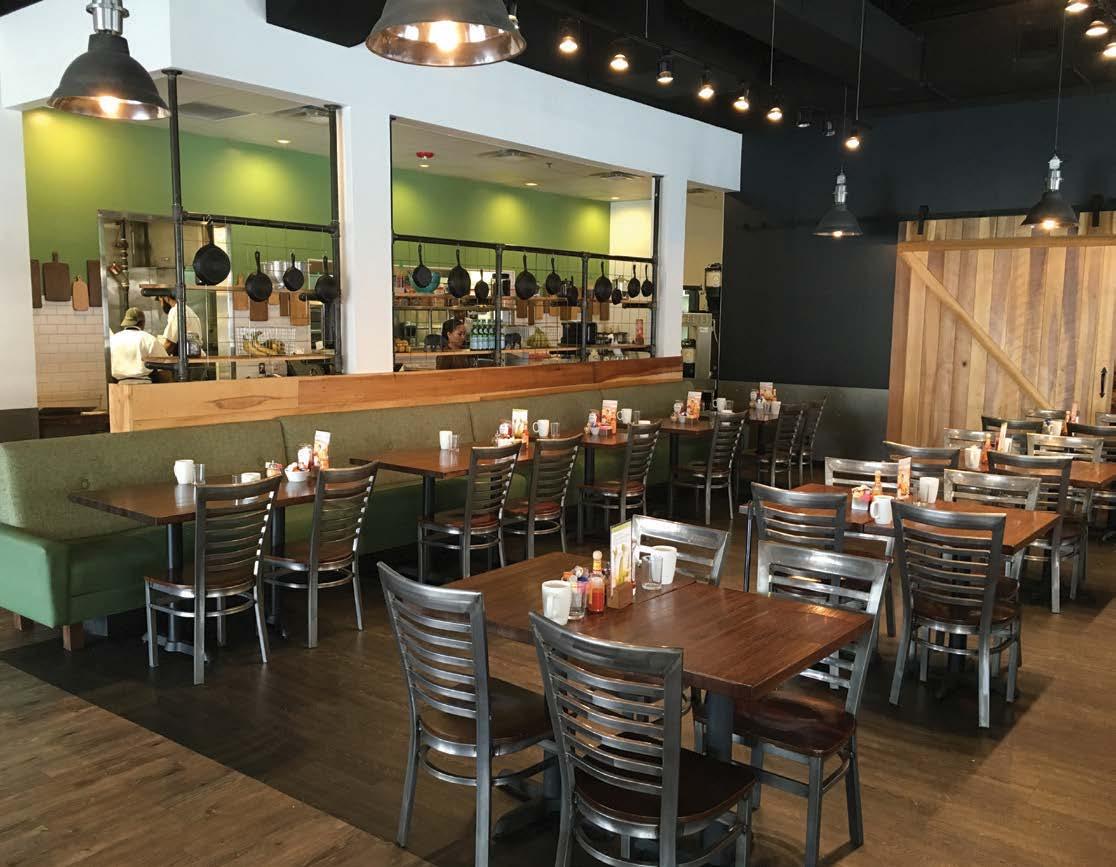
While Zimmer is still busy in Naples, he says that he always thinks back to the entrance of his team’s office. “Our door says ‘Development,’” Zimmer says. “I think we have arguably the best development team for a retail brand that’s working today.” As his network of general contractors get to work on new sites and his covert team of carpenters moves on to the next renovation site, Zimmer will move on from Naples, continuing First Watch’s 30-year-start-up boom.
“We
—Jon Bremer, Business Development Manager
PORTRAITS 115 WE KNOW hospitality Whether you’re looking to develop your restaurant, fill it with high-quality furnishings, or recruit the very best people in the service industry, get comfortable and let’s get down to business. 816.368.2857 | leaphospitality.com DEVELOPMENT FURNITURE RECRUITMENT LOGISTICS FIRST WATCH ORLANDO Leap Hospitality:
would like to congratulate Nathan Zimmer and the rest of the team at First Watch on the incredible growth they have experienced over the past few years. It’s been a privilege to work with them as their vendor and partner for their new restaurant furniture package. We look forward to continuing our relationship as they continue to grow and expand.”
“Even though our restaurants have been around for almost 30 years, it’s in recent years that we’ve really started to grow, making us one of the oldest start-up restaurant brands in the country.”

116 PORTRAITS
Alan McLenaghan Chief Executive Officer SageGlass
Be Transparent
CEO Alan McLenaghan uses authenticity and humility to drive the innovative nature of SageGlass and build a better team
By KC Esper
Growing up in a small town in Scotland, Alan McLenaghan was taught that education opened doors to anything he dreamt of doing. His widowed, deeply intelligent mother worked hard to provide for McLenaghan and his sister and guided them on a path toward university so they could “escape the treadmill of being a working-class person in Scotland.”
This path, however, led him on a different, equally challenging journey to become an educated, resourceful man. He studied in the fall and worked in the summer to afford his education and pave the road his mother always wanted for him.
McLenaghan was always interested in science— particularly in the fundamentals of chemistry. He was curious about how certain materials worked and how to develop the properties that made plastics soft, hard, or malleable. After earning a degree in applied chemistry, he earned his PhD in physical chemistry and materials. His dedication to his education provided him myriad opportunity around the world to work in manufacturing, building plants and working in nuclear reactors.
Eventually, McLenaghan joined Saint-Gobain, where he cut his teeth in the glass and construction
industries. Here, not only was McLenaghan recognized for his incredible work ethic but also his amicability.
When Saint-Gobain acquired SageGlass, McLenaghan was an obvious choice to head the operation. He and his wife moved to Minnesota to take on this new adventure, and in one year’s time, he was appointed CEO. Now, six years later, McLenaghan is using his influence to support SageGlass in its new ambitions, while inciting modern change to its internal operations.

In his position, McLenaghan emphasizes the importance of building a community based on transparency and humility. He feels that embodying these traits is imperative in allowing companies in the manufacturing industry, like SageGlass, to move forward by using a collective think-tank to drive strategy. He wants everyone working next to him and under him to feel welcomed and involved in the bigger picture of the company.
“I’ve never been afraid of not being the smartest person in the room. My job is to pull together the smartest people to form a team that can use each other to gather ideas and feel engaged in the material,” McLenaghan says. “I want to share our goals, values,
PORTRAITS 117
Ryan Siemers
wins, and losses to make people feel more included. Humility requires courage and trust, and with trust comes empowerment.”
Through his efforts, McLenaghan has developed a holistic view of authenticity inside the company. He has been instrumental in opening communication among his team to carry this authenticity, using weekly newsletters, email messages, social media, regular meetings, ad-hoc lunches, team member satisfaction surveys, and shared business performance reports.
He has also strived to strengthen SageGlass’ diversity and inclusion by being hyper-mindful of the kinds of people he hires daily. In six years, his efforts have increased the number of women in the company’s workforce from 7 percent to 30 percent and have built an incredibly diverse team composed of people who speak 26 different languages.
Just as McLenaghan strives to connect his team internally, SageGlass’ products reflect his mission by providing dynamic glass options that comfortably connect building occupants to the outdoors. But SageGlass’ products are more than just glass—they’re dynamic, adapting windows that allow occupants to interact with the outdoors, but be in control of the connection.
“Our glass blocks unwanted heat and glare, while maximizing daylight and access to the outdoors for the occupants in the building,” McLenaghan explains. “It leads to happier, healthier, and more productive people, which is the largest asset to any building.”
In the last six years, McLenaghan has increased the number of women in the company from 7 to 30 percent.
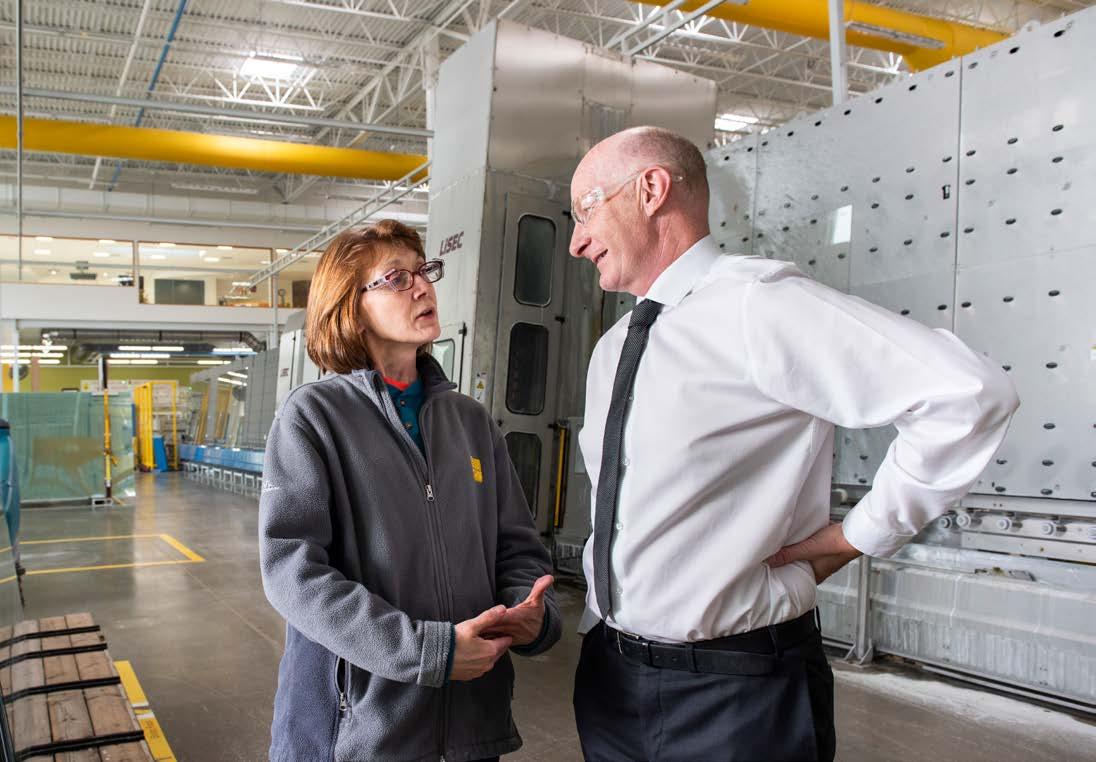
118 PORTRAITS
“Our glass leads to happier, healthier, and more productive people, which is the largest asset to any building.”
Ryan Siemers
As the company continues to grow globally, it hopes to transform smart glass into the norm—to be relevant for all applications and buildings. In addition to constantly updating its products, SageGlass is also looking into new pricing options, charging customers a small fee over time, rather than the whole sum upfront, to make its products more accessible. McLenaghan says, “We continually discover more use cases for dynamic glazing. In the end, our goal is to constantly evolve in innovative ways to make people’s experiences in a building refreshing.” Wholly, SageGlass’ windows change the way people experience spaces in buildings just as much as it changes how architects and designers use glass to heighten their projects.

At the same time that SageGlass moves forward, creating the windows of the future, McLenaghan
hopes to continue developing as a compelling, compassionate leader. His goal, in life and his career, is to “live a different day every day.” In other words, to live a life of purpose that strives toward advancing as a leader and an innovator.
He believes that his behavior as CEO determines the success or failure of the company, encouraging him to translate his passion for betterment into his work by taking risks, caring deeply about the people around him and the world we inhabit, changing the way SageGlass approaches its products to make a difference in the world, and of course, accentuating transparency and humility with regard to everything he does. At SageGlass, whether it’s building a team and or creating dynamic windows, transparency is the key to success.
PORTRAITS 119
McLenaghan builds a community based on humility and transparency.

120 PORTRAITS
Baker Hughes operates on the company’s mission to “do the right thing, always.”
Courtesy of Baker Hughes
Take It Personally
Baker Hughes’ Mark Seale says building isn’t just business
 By Billy Yost
By Billy Yost
PORTRAITS 121
“The three words that I absolutely cannot stand hearing are, ‘It’s just business.’”
Mark Seale doesn’t think the adage has any place in the creative community. “If you’re not taking your job personally, then why are you doing it?” Seale asks. The real estate project leader at Baker Hughes (BH), one of the largest oil field services companies in the world, has solid grounds for his perspective.
“You have blood, sweat, and tears poured into these projects and these buildings, there are flights to North Dakota where I’m leaving the house at 4 a.m. to jump on a plane: these are all personal investments into the job,” Seale explains. “These projects can take 12, 14, or sometimes 18 months; that’s a commitment both for the company and for the people taking the time to do it—it is personal.”
Though his title may be “leader,” Seale is a born builder. While attending construction management classes at night, Seale spent days as a construction carpenter. He eventually wound up at Falcon Group Construction and Development for a dozen years where he says the bulk of his work was of the design-build format, a process that has continued to influence his career. “There was a time when we were still bidding open market projects with that ‘low-man-wins’ mental-
ity, but that has never been my preferred method of construction.” It’s an outlook that would pay dividends in coming to Baker Hughes, where Seale and his team only use the design-build format.

Seale emphasizes the importance of cultivating a solid group of contractors to properly assemble a design team that can be called upon whenever a need for a new or upgraded facility is due. He explains that during traditional construction, each person from owner to architect to engineer is siloed in their own responsibilities, whereas in design-build, the process is far more collaborative. “You’ve got the contractor building with the team. I’m part of the team. The user group from the operations perspective is part of the team—we’re all responsible for the intent of what we wanted.”
Early on after he joined BH, Seale was in charge of overseeing real estate projects in North America, Latin America, and parts of western Africa. “There were only three or four of us in the whole company,” Seale says about working to address projects that encompassed nearly half the world. As business needs expanded and facility management staff hiring increased, Seale’s workload grew so much that he refocused to North America only, while two other project leaders took on the work formerly being done by Seale alone.
During nearly 14 years at Baker Hughes, Seale had built literal millions of square footage. From 2010
122 PORTRAITS
Baker Hughes has locations across 120 different countries. Joe Aker
to 2013, Seale estimates he did $300 million worth of construction, a Herculean undertaking by any measurement. “At that time, North Dakota had sort of turned into the very definition of a modern-day boomtown,” Seale says of the massive influx of oil and gas drilling in the region. Four facilities there alone cost around $25 million each.
Seale also oversaw construction of BH’s region center in Oklahoma City. The 72-acre site included 250,000 square feet of manufacturing space, 125,000 feet of operational shop space, and 90,000 feet of office space. The $85-million project was, as Seale prefers, a design-build project.






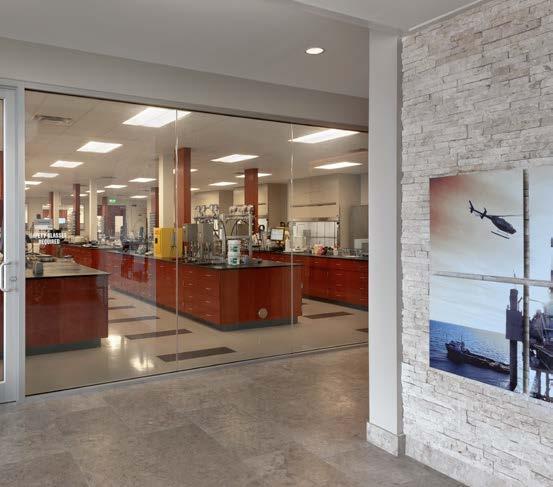

Whether the project is a mammoth undertaking like Oklahoma City or something much smaller, Seale’s leadership style remains fundamentally the same. “I’d call it collaborative authoritarianism,” Seale laughs. “I expect people that work with me to know what they’re doing and not need me to hold their hands, but at some points someone has to make those hard decisions.”
Seale doesn’t shy away from that role, but says when things are running smoothly, especially on the facilities management, then his oversight may be a simple check-in for the latest news.


While the latest news is imperative, Seale says “the latest” in technology has a habit of inhibiting what he considers the fundamental principles of being a builder. “I think one of the biggest things that people sometimes misunderstand is that you can’t do the job of a real estate or construction project manager by sitting at a desk,” Seale explains. “I don’t really have any interest in only downloading a hundred photographs of a location, a drone video flying over the site, and having a Skype meeting to discuss it.” While Seale says there are great technologies that help promote better and smarter building, the fact remains that the real estate managers at Baker Hughes all retain the same approach. “We’re boots-on-the-ground people,” Seale says.
Currently, Seale says Baker Hughes is in the process of reorganizing its real estate group after its merger with GE Oil and Gas. That exponential growth of portfolio requires a shift away from an all-in-one-per-pointof-contact to an organization tied to a regionally based strategic portfolio management group and a regional project management group. “In order to accommodate this growth, we’ll employ managers to oversee the various regions, and while it may be trying to make that adjustment from a legacy perspective, we’re having


meetings now to figure out just what this is going to look like and how to get through those transition pains.”










While Seale may not take those growing pains personally, he says he’ll continue to approach the rest of his job with just as much passion as he always has. “I feel good about my own personal investment here and what I provide the company, and to develop facilities I can be proud of building,” Seale says, as he is intimately involved in the entire process from initial operational need to completing the facility utilizing the design-build method. “If you’re on the creative side of any endeavor, you’re going to commit your time and self to that endeavor, and you’ve got to take that commitment personally.”

PORTRAITS 123 713.921.2500 | benchmarkhouston.com DESIGN BUILD CONSTRUCTION MANAGEMENT
The Value
Iron Mountain’s Sarah Abrams drives change while giving back to the corporate real estate industry
By Will Grant
of Why
124 PORTRAITS
Sarah Abrams likes to use analogies to drive home a message, particularly when making a case for change. In coming to Iron Mountain in 2012, after successfully aligning Fidelity’s real estate team as a strategic partner to the business, the senior vice president of global real estate needed to not only create a compelling value proposition for change in the real estate function, but also articulate a road map for how to implement the change.
“How you choose to integrate your work into your life impacts what you are capable of doing and contributing outside of work.”

PORTRAITS 125
Tom Fallon Photography
“Let’s say I know there’s going to be an earthquake in California, and I communicate to the team that we need to leave and go to New York. I’ve created a compelling value proposition about why we need to leave, but until I communicate how we are going to reach New York— plane, train, automobile—I haven’t provided the team with a road map for getting us there,” Abrams explains, emphasizing the importance of using both elements to encourage successful change. “Visions without road maps rarely get achieved.”
Abrams is a self-described “business person with a lot of real estate experience.” Having started her career working for a real estate developer before switching to corporate real estate about 10 years later, she’s amassed significant experience to become a wellrespected industry thought-leader.

Abrams’s arrival at Iron Mountain provided her with an interesting set of challenges. “The real estate function was not centralized,” she recalls, adding that she was hired “not only to change the way the function operated, but to change the company-wide perception of it from tactical and reactive to a strategic business partner.”
Abrams says driving a transformation and then continuing to improve year after year has required continued evolution of her organization from both a structure and skill set perspective as Iron Mountain has added new businesses in high-end art storage and logistics, data centers, cloud offerings, and digital solutions. “I always say that corporate real estate organiza-
tions are organic and need to evolve as our business unit clients evolve,” she says. “My team’s North Star is enabling Iron Mountain’s business, and I am very fortunate that they don’t miss a beat.”
Employing a more Boston-specific analogy in speaking about assembling her leadership team, Abrams compares the process to the success of the Red Sox in 2018. “If you think of a baseball team, I tried to operate like a good general manager,” she says. “We had a core of truly great people and after bringing in a few key outside players, we were ready to compete for the World Series.” Her continual focus on talent development and organizational adaptability has allowed her team to leverage its expertise to deliver value, control costs, and mitigate risks across Iron Mountain’s 56-country and 88MSF footprint.
Seven years in, Abrams credits the exceptional way her team functions as a cohesive and collaborative unit and their satisfaction with their work and opportunities as what bring her the most satisfaction in her role.
Iron Mountain has utilized Abrams’s overall business acumen and public speaking skills by having her work closely with the commercial side of its business on various initiatives. “I’ve had the opportunity to be very engaged with our marketing teams and sales organization to make sure that we can speak authentically and compellingly when we present our specific products and services that are valuable to real estate and technology leaders,” she says. “I have very much enjoyed meeting
126 PORTRAITS
Sarah Abrams SVP of Global Real Estate Iron Mountain
“My team’s North Star is enabling Iron Mountain’s business, and I’m very fortunate that they don’t miss a beat.”
Mark Karlsberg/Studio Eleven
Having open spaces for collaboration is critical to the company’s success.
Allowing natural light to stream into work areas is a key factor in motivation.
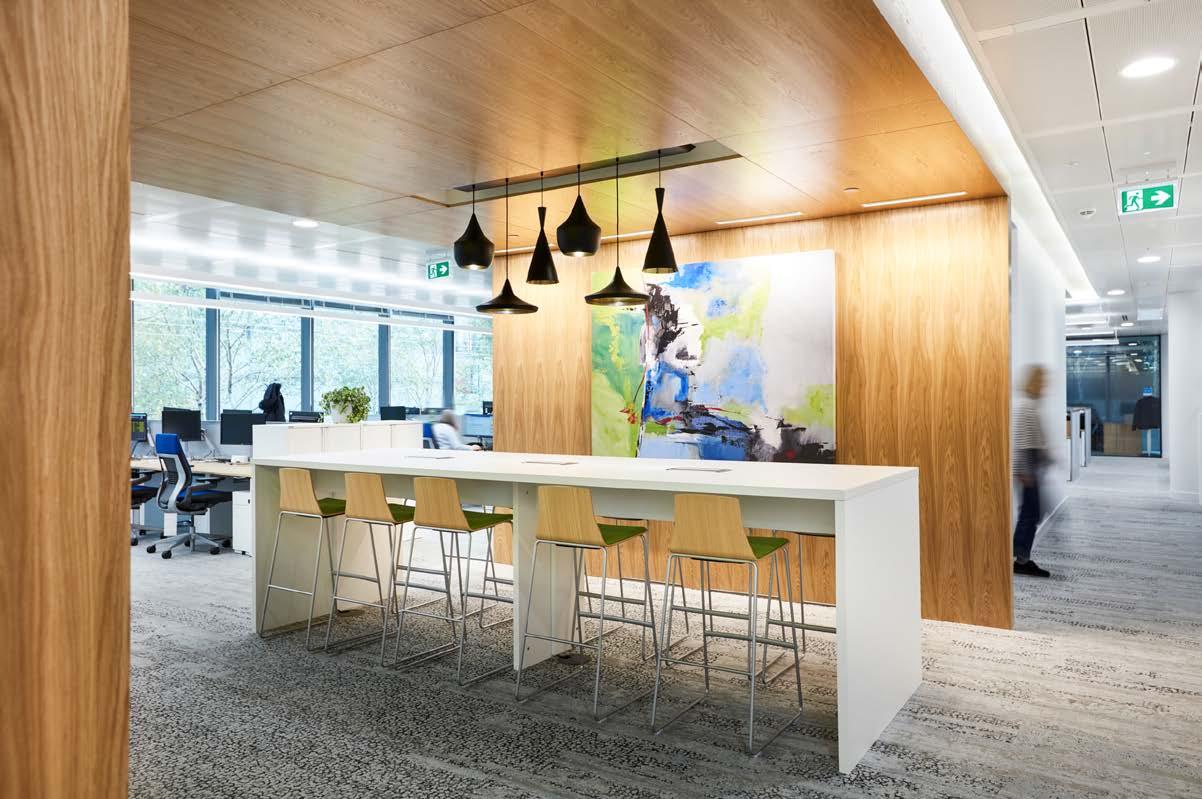
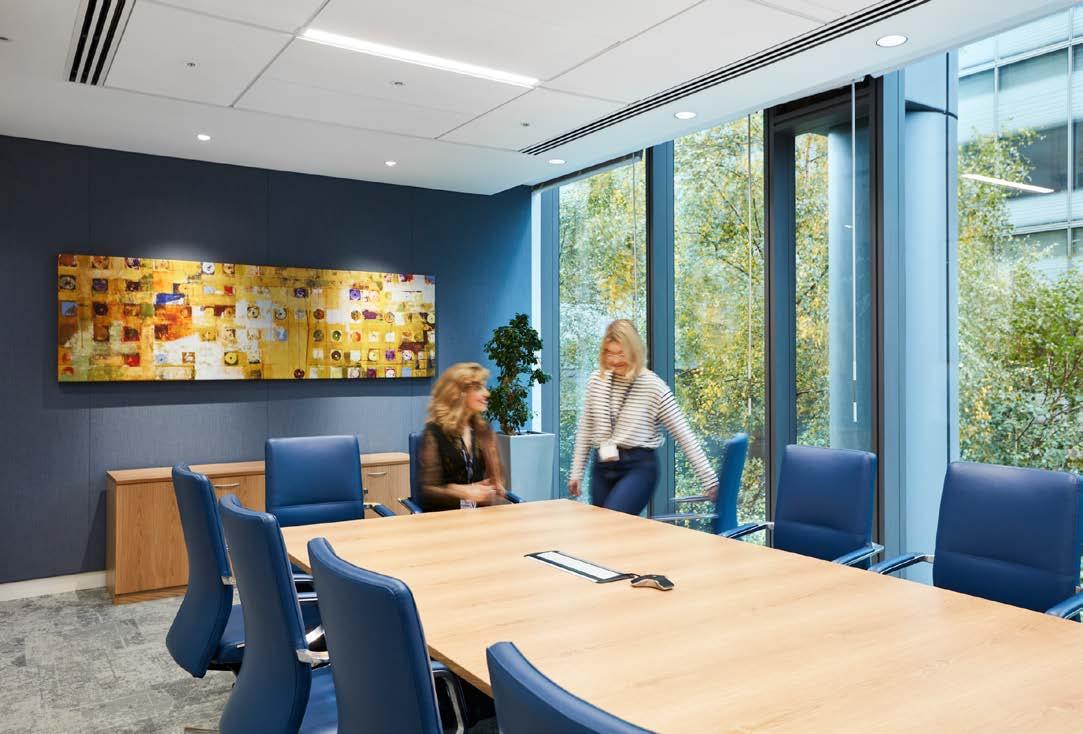
PORTRAITS 127
Tom Fallon Photography
our clients directly in one-on-one meetings or by speaking on topics important to them at customer forums.”
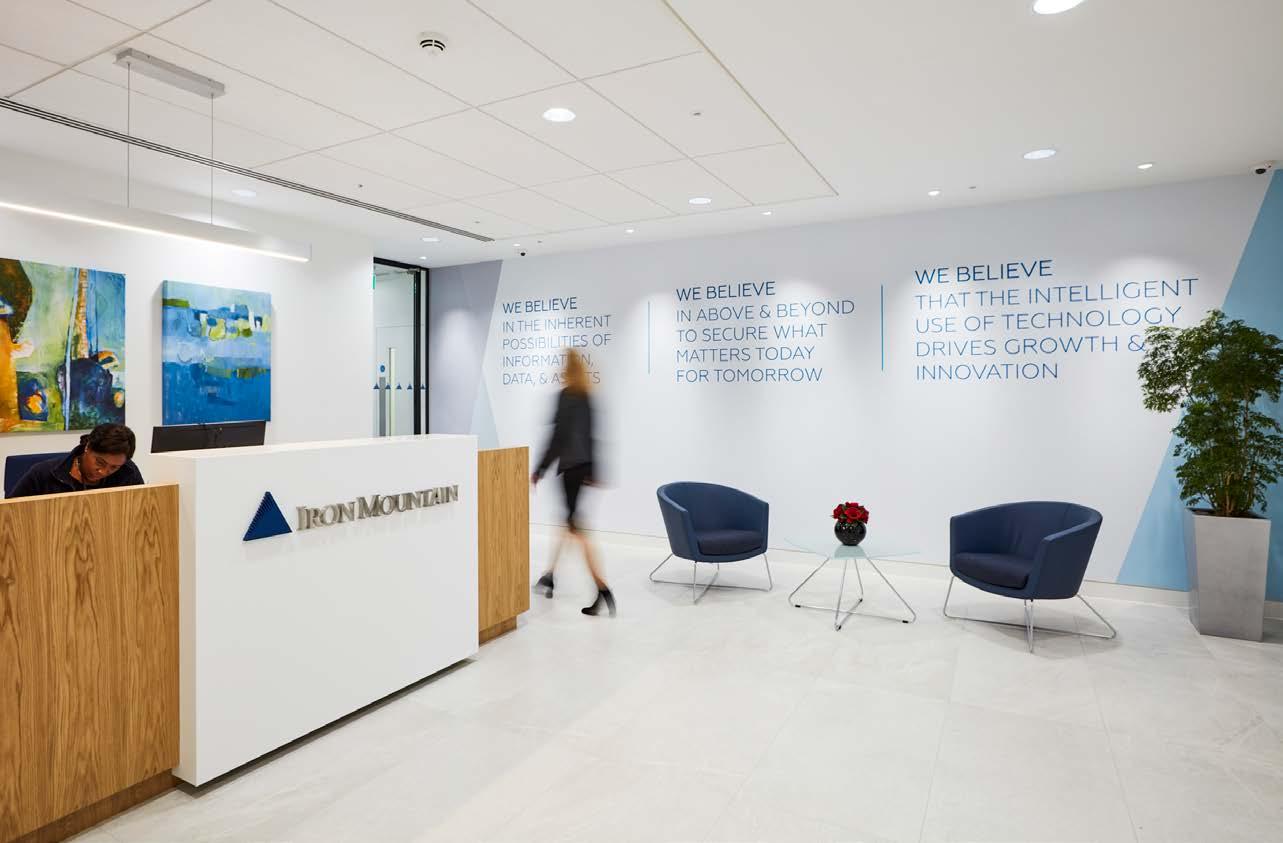
In addition to leading the global real estate function for Iron Mountain, Abrams devotes many hours to the profession mentoring, teaching, and developing young leaders. As a past president and board member of the New England Chapter of CoreNet Global, the professional association for the corporate real estate industry, Abrams helped found the chapter’s Young Leaders Professional Development program, a yearlong program of substantive classes, networking opportunities, and personal coaching and development.
As chair of the chapter’s University Initiative, Abrams also visits college campuses in the Boston area each fall to introduce students to the corporate real estate industry and holds an adjunct faculty appointment at MIT’s Center for Real Estate where she teaches an Introduction to Corporate Real Estate course to graduate students. For her professional and industry contributions, Abrams was awarded CoreNet Global’s Executive of the Year in 2013 and received the New England Chapter’s Presidents Award in 2018.
Abrams has not let her career stand in the way of an involved family life. When her son, who is now a high
school senior, was younger, she coached his baseball team, served as a room mother for his fourth grade class, and attended nearly every one of his school and AAU basketball games. She continues to encourage those who work for her to devote the time necessary to participate fully in their children’s lives.
She says she is energized by managing her life to accommodate her family, a demanding career, leadership in her industry, and community work—such as the multimillion-dollar renovation of her synagogue that she recently led—because she loves it all. However, she dislikes the term “work/life balance,” explaining that, “the word ‘balance’ makes you think of a scale with work and life at opposite ends and only one correct point that balances everything. I prefer to think of it as a Venn diagram with ‘life’ as the big circle and ‘work’ as a smaller circle within it.
“To me that is work/life integration because work is a part of life and how you choose to integrate your work into your life impacts what you are capable of doing and contributing outside of work,” Abrams explains. “I have work that I am passionate about, a healthy, loving family, and people I respect and enjoy working with every day. I consider myself a very lucky person!”
128 PORTRAITS
Tom Fallon Photography









Eagle provides project management and facility maintenance services, 24/7 throughout North America. 500 N Walnut Rd, Kennett Square, PA 19348 1-877-990-3245 | www. eaglsys.com Electrical Lighting CCTV Access Control Generators Critical Infrastructure Fire Alarm Abrams
Success! STBoston_ABQ_Iron Mountain_qtr-pg_fin.pdf 1 5/6/19 11:48 AM
This Recognition.
Iron Mountain’s new western Europe headquarters was designed by the London office of Stantec, with AIS Workplace serving as the general contractor.
Developing Tomorrow’s Curious Minds

130 PORTRAITS
anyaivanova/Shutterstock.com
Melody Spradlin on engineering and supporting Gilead’s lifesaving mission
 By Will Grant
By Will Grant
PORTRAITS 131
As a young ensign in the US Navy Civil Engineer Corp, Melody Spradlin credits the inquisitive nature she embraced when having discussions with the seasoned, experienced personnel. It was imperative to listen to them, she says, adding that “you don’t need to be an expert on everything. I was successful in my role because I was always curious and eager to learn from those around me, while simultaneously maintaining project leadership.”
Spradlin continued to exercise her leadership muscles during her time as a junior officer through complex projects such as the operational warfare control centers, and repair of active runways and flight simulators. Now an executive director of engineering at Gilead Sciences Inc., she leads teams to align facilities, construction, and design efforts within Gilead’s mission to support the researchers with a facility that enables them to deliver life-saving medicines to patients. And in the process, Spradlin is helping the company inspire a new generation of engineers and builders.
The facility engineering world, known for being predominantly male, lacks not only women but also people of color in leadership positions. With recruitment and retention also being major issues, Spradlin works to engage and inspire the younger generation of women and people of color to initiate change and introduce more diversity into leadership.
Spradlin’s varied work experience includes clinical supply chain, sourcing, and operations. Serving in leadership positions in areas other than construction has helped her understand that teams and companies must have a shared vision for success. “At Gilead, science is the backbone of everything we do and we are committed to improving the lives of people who use
our products,” Spradlin says. “That mind-set helps me understand how to prioritize and make decisions based on what is best for Gilead as a whole.”
At Gilead, Spradlin has mentored several team members who are spearheading collaboration with the facilities and engineering groups to operate with what she calls “intentionality.” She adds that everyone should understand the vision clearly then plan their work around it.
For more than 25 years, she has been developing operationalizing Building Information Models (BIM), which have traditionally been used to ease the coordination
132 PORTRAITS
“I’ve always had a passion for providing STEM learning opportunities for those interested, particularly women and those underrepresented in science, technology, and engineering.”
of multiple systems and are now proving beneficial in construction to minimize rework and optimize reliability.
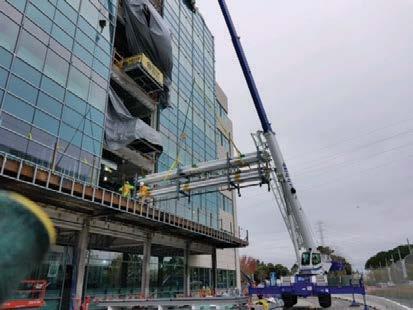
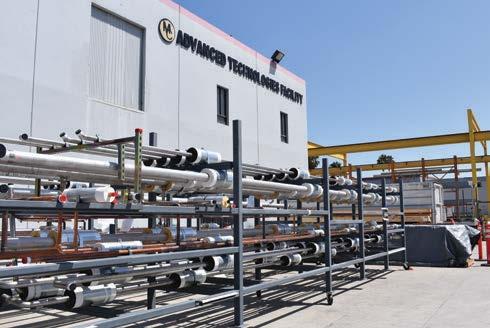
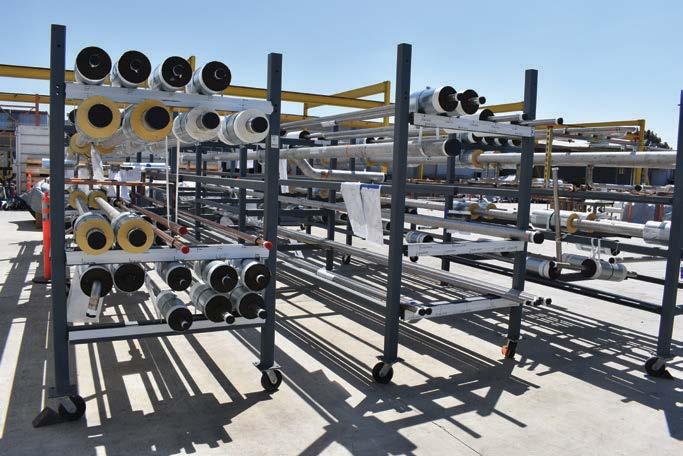

Gilead is also examining IoTs, machine learning and artificial intelligence, and augmented reality solutions with the goals of saving energy, increasing communication between systems to allow data analysis, and increasing the reliability and uptimes of facilities. These initiatives include introducing smart classes to improve remote equipment support capabilities and to process data in real time.

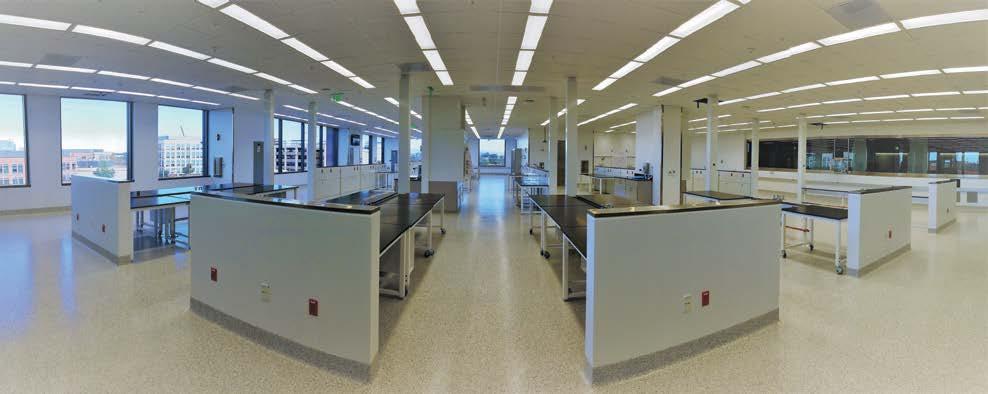
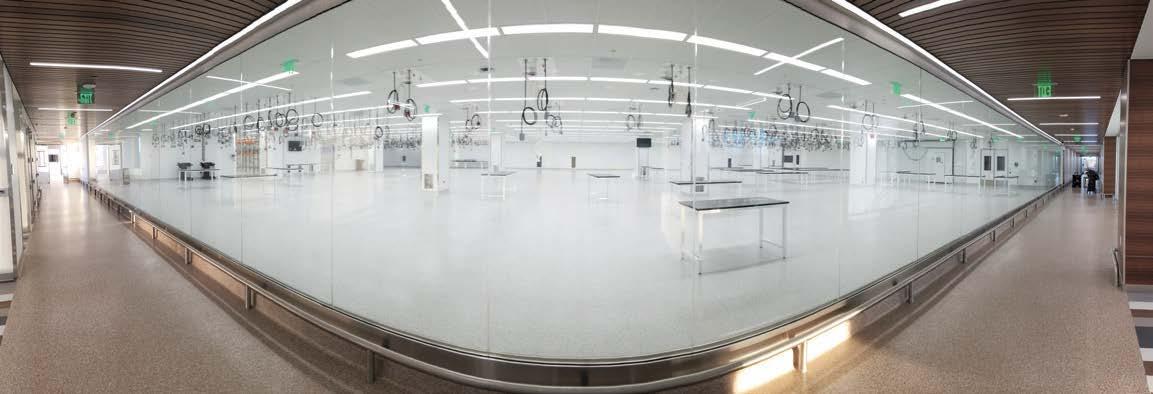
Outside of technological innovations, Spradlin co-leads a STEM outreach program for high and middle-school students in Foster City, California. She is also a member of Gilead’s employee resource group, Women at Gilead, which sponsors a STEM Career Day that hosts approximately 200 students from 9 Bay Area high schools. Students hear from women in a number of roles at Gilead, from engineering to medicinal chemistry, while 45 Gilead volunteers lead experiments, share their journeys, and answer questions about STEM careers.
“I’ve always had a passion for providing STEM learning opportunities for those interested, particularly women and those underrepresented in science, technology, and engineering,” Spradlin says. “Diversity of opinion really makes a huge business impact and it’s important to value many perspectives.”
Spradlin is also a leader of the Gilead employee resource group for veterans, GVETS. She says the group is preparing to partner with the Naval Academy (her alma mater), to bring five interns to Gilead during the summer. Recently, Gilead hosted an engineering consortium, inviting people from various industries to present on different topics. “Though our day-to-day activities may be different, there is so much we can learn from other industries about how to be efficient,” Spradlin says.
Spradlin’s own curiosity and lifelong love of learning lead her back to Stanford University, where she is currently pursuing her PhD with Gilead’s full support. Spradlin’s own grandmother went back to school to finish her degree while her four daughters were in school. Now with four grown daughters of her own, Spradlin is focusing her studies on the implications of improving connectivity and reliability of medical clinics in Africa to help continuity of care.
“The current studies have given me a broader sense of what my colleagues at Gilead do to deliver life-saving products to millions of people around the world, particularly in developing countries.”
Oakridge Industries Inc. has been in the resinous flooring and coatings industry for over 35 years and we pride ourselves on exceptional customer service, high quality workmanship and Integrity. Our extensive experience, knowledge and passion for what we do is what sets us apart from the competition. www.oakridgeindustries.com
on your success Specializing in the Biotech and Pharmaceutical manufacturing industry. CLEAN ROOMS | HOSPITALS | HEALTHCARE | RESEARCH FACILITIES VIVARIUM’S | LABS | FOOD & BEVERAGE CHEMICAL CONTAINMENT AREAS | SPORTS FACILITIES UNIVERSITIES & EDUCATIONAL FACILITIES
Melody Spradlin Congratulations
As she continues to ask important questions of her own, Spradlin also says that her goal isn’t to be the only one with the information, but to be an agile leader who inspires those around her without focusing too heavily on task-mastering. “I believe leaders are visionary architects who connect teams, rather than directing or controlling. Being a point of intersection between groups is where leaders can do that most.”

She goes on to note that she is energized by working with outstanding teams where everybody contributes a piece to the puzzle, explaining, “It takes everyone working together to create that collective genius that allows us to achieve excellence, which is one of Gilead’s core values.”
Despite her impressive collection of accomplishments, Spradlin focuses on the success of those who have worked under her, which has given her a frontrow seat to their victories. “One of the most rewarding parts of my long career has been seeing the incredible success of my mentees, including Raj Radhakrishnan, Lily Rasovsky, Delvin Harvey, and William Merrill,” she says. “I have also learned how to recharge so that I can focus on each of the three pillars in my life: family, community, and work; and the success of my own community makes me so proud. I’m grateful for what I have and optimistic for what I can achieve.”
Editor’s Note: At press time, Melody Spradlin was no longer with Gilead Sciences.


Site/Structural Concrete • Structural Formwork • Concrete Pumping Saw Cutting/Core Drilling • Grading and Paving • Shotcrete Demolition • Masonry • Reinforcement • Equipment Rentals We Just Get It Done. Safely. CA LIC # 299880 408.727.5700 jjalbanese.com We are proud to support Melody Spradlin and Gilead Sciences. Congratulations on being recognized for your leadership and vision. (925)461-4301 | www.Kaelinconstruction.com
Congratulations Melody Spradlin on this well-deserved recognition. Murray Company takes great pride in our partnership with Gilead Sciences. We appreciate the opportunity to partner with your outstanding team as it delivers life-enhancing remedies and solutions to people across the globe every day. Again, congratulations!
BUILDING A STRONGER BAY AREA TOGETHER
McCarthy Building Companies congratulates Melody Spradlin and Gilead Sciences on their recognition by American Builders Quarterly.

We’re honored to partner with Gilead to build a world-class campus that supports their mission to advance scientific innovation.
mccarthy.com
making space

for a room of one’s own
Odile Decq, founder of Studio Odile Decq and Confluence Institute

“I’m not a static person. I’m a person in movement all the time, and I always go further. So I like when people in my buildings do the same.”
Frida Escobedo
Named one of the top 30 most influential architects by ArchDaily, Escobedo is also the single youngest architect to have designed the annual Serpentine Pavilion in London’s Kensington Garden. Escobedo, a native of Mexico, infused the pavilion’s design with a nod to the Mexican celosia (breeze walls) that brings natural light to the space.

136 POINTS OF INTEREST
Columbia GSAPP/ Wikipedia.org (Odile Decq), StockPhotosArt ’s/Shut terstock.com (Amanda Levete), Columbia GSAPP/Wik ipedia.org (Frida Escobido)
Norma Sklarek
Often regarded as the “Rosa Parks of Architecture,” Sklarek tenaciously made a name for herself, first as a project manager then later as an architectural designer in her own right. She rose the ranks at various firms until ultimately cofounding her own, Siegel Sklarek Diamond, alongside Margot Siegel and Katherine Diamond. In 2008, Sklarek was awarded the Whitney M. Young Jr. Award for her embodiment of the profession’s responsibility to address social issues.



Mary Gannon and Alice Hands
In 1894, New Yorkers Mary Gannon and Alice Hands formed the first-ever partnership of women architects in the US. This effort led them to seek social justice through improvement of local city housing. They spent an entire winter living in a tenement to experience the conditions firsthand, thereby identifying specific concepts and approaches to reform low-cost, urban housing.
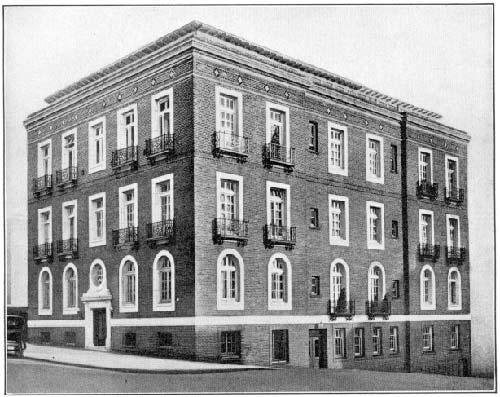
POINTS OF INTEREST 137
Amanda Levete, principal architect of AL_A Studio
“Women, in my experience, are natural risk takers but also pragmatists—the perfect combination for leadership. It’s time to reclaim and celebrate risk in architecture as a positive force.”
Library o f Congress (Norma
http://www.homeoint.org/books3/hospital/acc redited9.htm (Mary
and
Carol M. Highsmith Collection at the
Sklarek),
Gannon
Alice Hands)
This issue’s visual concept was the product of months of collaboration between staff photographer Cass Davis and senior designer Lauren Keeling—from brainstorming to balancing to beautifying. The two worked together to develop the ideas and hand build the sets that became the still lifes flowing through the magazine.

138 ONE LAST LOOK
Cass Davis

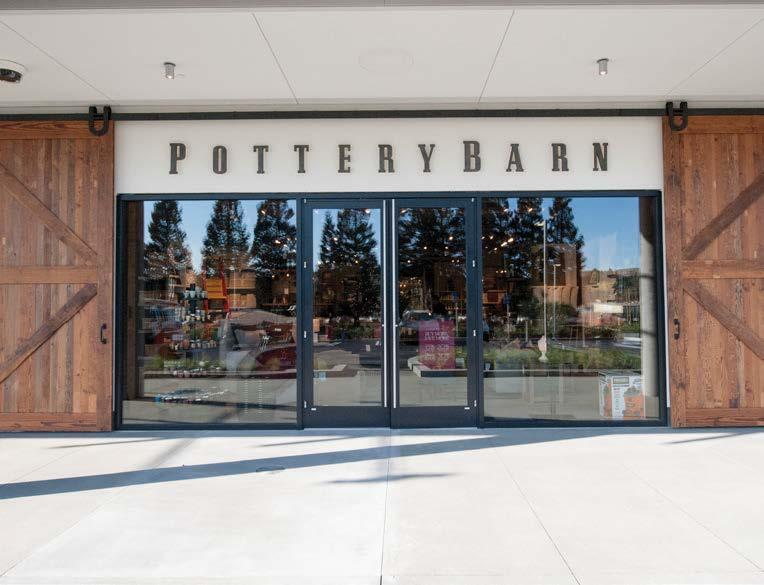
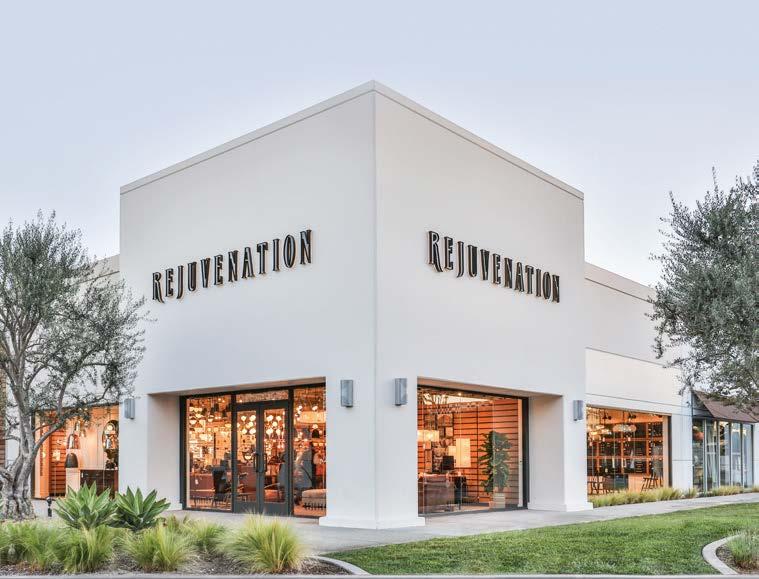

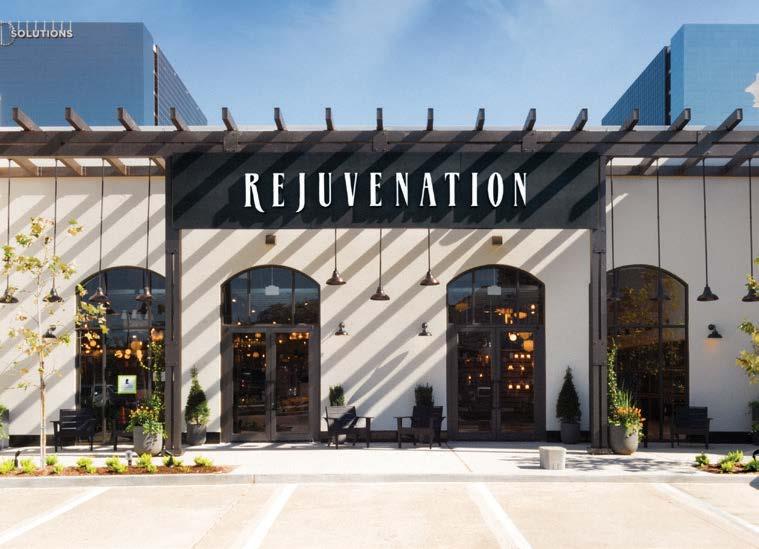

ILLUMINATING THE WORLD’S BEST BRANDS SAN DIEGO, CALIFORNIA - NATIONWIDE - INTERNATIONAL 1.877.885.1135 - SIGNTECH.COM PROJECT MANAGEMENT + DESIGN + FABRICATION + INSTALLATION As a preferred partner to Williams Sonoma, Signtech extends our world-class capabilities to offer high-end custom signage, architectural products as well as a premier level of service and commitment in our project management, fabrication and installation.
Where’s the right balance?
Enterprise-level strategic decision makers should consider whether they’re striking the right balance between real estate and facilities costs, effective service delivery, technology enablement and delivering engaging and increasingly digital employee experiences. As objective real estate advisors Deloitte’s Real Estate Transformation practice helps organizations address some of their most complex and challenging real estate issues.
What we’re after is helping clients create more value, improve service delivery, and mitigate risk.
www.deloitte.com/us/transformrealestate

Copyright © 2019 Deloitte Development LLC. All rights reserved.















































 By Billy Yost
By Billy Yost























































 By Russ Klettke
By Russ Klettke

















 By Billy Yost
By Billy Yost



























 By Lior Phillips
By Lior Phillips






 By Melaina K. de la Cruz
By Melaina K. de la Cruz











 CEO Hamid Hashemi channels the glory days of movie theaters from the ’30s and ’40s by offering luxurious accommodations such as swinging hammock chairs.
Sequoia Group
Karen Fuchs
CEO Hamid Hashemi channels the glory days of movie theaters from the ’30s and ’40s by offering luxurious accommodations such as swinging hammock chairs.
Sequoia Group
Karen Fuchs







 By Billy Yost
By Billy Yost
























 By Will Grant
By Will Grant

























